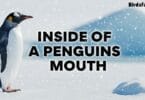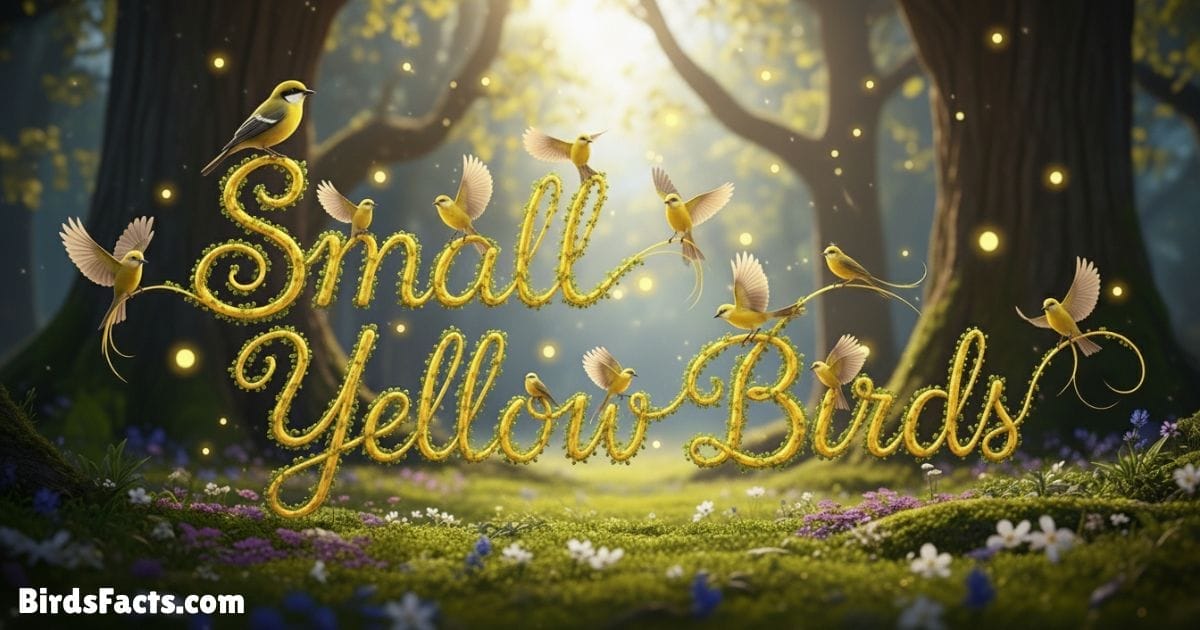
Small Yellow Birds
Have You Ever Looked Out Your Window And Spotted A Flash Of Yellow Darting Between The Trees Only To Wonder What Kind Of Bird It Was It Can Be A Little Frustrating When You See These Tiny Colorful Visitors But Can’t Put A Name To Them Many People Who Enjoy Back Yard Bird Watching Feel The Same Curiosity Especially When It Comes To Identifying Small Yellow Birds
These Cheerful Little Creatures Are More Than Just Pretty Sights They Often Bring Energy And Music To Gardens Parks And Even City Spaces Learning How To Recognize Different Species Of Small Yellow Birds Can Make Your Bird Watching More Exciting And Rewarding Once You Know Who They Are You’ll Start Noticing Their Habits Songs And Favorite Hangout Spots In A Whole New Way Observing Small Yellow Birds Turns Every Day Into A Mini Nature Adventure
Small Yellow Birds
- American Goldfinch
- Bananaquit
- Canada Warbler
- Cape May Warbler
- Citrine Wagtail
- Common Yellowthroat
- Female American Redstart
- Golden Tanager
- Golden-Headed Manakin
- Grey Wagtail
- Grey-Crowned Yellowthroat
- Hooded Warbler
- Lesser Goldfinch
- Magnolia Warbler
- Nashville Warbler
- Palm Warbler
- Pine Warbler
- Prothonotary Warbler
- Saffron Finch
- Townsend Warbler
- Verdin
- White-Eyed Vireo
- Wilson’s Warbler
- Yellow-Bellied Elaenia
- Yellow-Bellied Sunbird
- Yellow-Breasted Chat
- Yellow Canary
- Yellow-Fronted Canary
- Yellow-Headed Wagtail
- Yellow Oriole
- Yellow-Throated Vireo
- Yellow Warbler
- Yellow Cardinal
American Goldfinch

American goldfinch perched on sunflower showing bright yellow plumage and black wings
The American Goldfinch Is Perhaps The Most Recognized Of All Small Yellow Birds In North America. Males In Summer Display A Dazzling Lemon Yellow Body With Black Wings And A Sharp Black Cap While Females And Winter Birds Wear More Muted Tones. They Are Highly Social Finches Often Feeding In Flocks And Visiting Backyard Feeders In Large Numbers. Known For Their Rollercoaster Like Flight Pattern These Goldfinches Are Also Unique For Molting Into New Feathers Twice A Year Once In Spring And Once In Late Summer.
Their Diet Mainly Consists Of Seeds Particularly From Sunflowers Thistles And Dandelions Making Them A Frequent Visitor To Feeders Stocked With Nyjer Seed. Unlike Many Other Songbirds They Nest Later In Summer Timing Reproduction With The Abundance Of Thistle Plants. Their Cheerful Calls Often Sounding Like Per Chick O Ree Are Easy To Recognize Among Other Small Yellow Birds Watching Them At Feeders Feels Like Having A Splash Of Sunshine Fluttering Around Your Garden And Reminds You Why Small Yellow Birds Are So Loved By Birdwatchers Everywhere.
| Facts | Detail |
|---|---|
| Range | Found Across North America In Fields Gardens And Open Areas |
| Key Fact | Bright Yellow Body With Black Wings And Cap Males In Summer |
| Plumage | Bright Yellow In Males During Summer Duller Olive In Winter Females |
| Behavior | Rollercoaster Flight Pattern And Late Summer Nester |
| Diet | Loves Thistle And Sunflower Seeds |
Bananaquit

Bananaquit perched on branch with black upperparts, yellow underparts, and curved white-striped bill
The Bananaquit Is A Lesser Known But Equally Fascinating Member Of The Small Yellow Birds Found Mostly In The Caribbean Central America And Parts Of South America. Its Plumage Is Striking With A Bright Yellow Belly Black Back And A Sharp White Eyebrow Line. Though Tiny In Size It Is A Bold And Active Bird That Often Visits Gardens Especially Where Nectar Feeders Are Available. In Fact It Is One Of The Few Non Hummingbirds That Frequently Drinks Nectar.
This Charming Species Has Adapted Perfectly To Urban And Suburban Environments Becoming A Familiar Sight In Many Tropical Gardens. Its Curved Bill Is Ideal For Sipping From Flowers Though It Also Feeds On Fruits And Insects. The Bananaquit Is Highly Adaptable Sometimes Building Its Nest Near Human Homes And Returning To The Same Territories Year After Year. For Bird Watchers Traveling In The Caribbean It Stands Out Among Other Small Yellow Birds Adding A Burst Of Energy To Every Outing. Watching These Small Yellow Birds Dart Among Blossoms Is Like Seeing Sunshine Come Alive.
| Facts | Detail |
|---|---|
| Range | Native To The Caribbean / Central America / South America |
| Key Fact | Yellow Belly With Black Back And White Eyebrow Stripe |
| Plumage | Black Back Yellow Underparts And Distinctive White Eyebrow Stripe |
| Behavior | Active Bold And Common In Tropical Gardens |
| Diet | Drinks Nectar Like Hummingbirds |
Canada Warbler
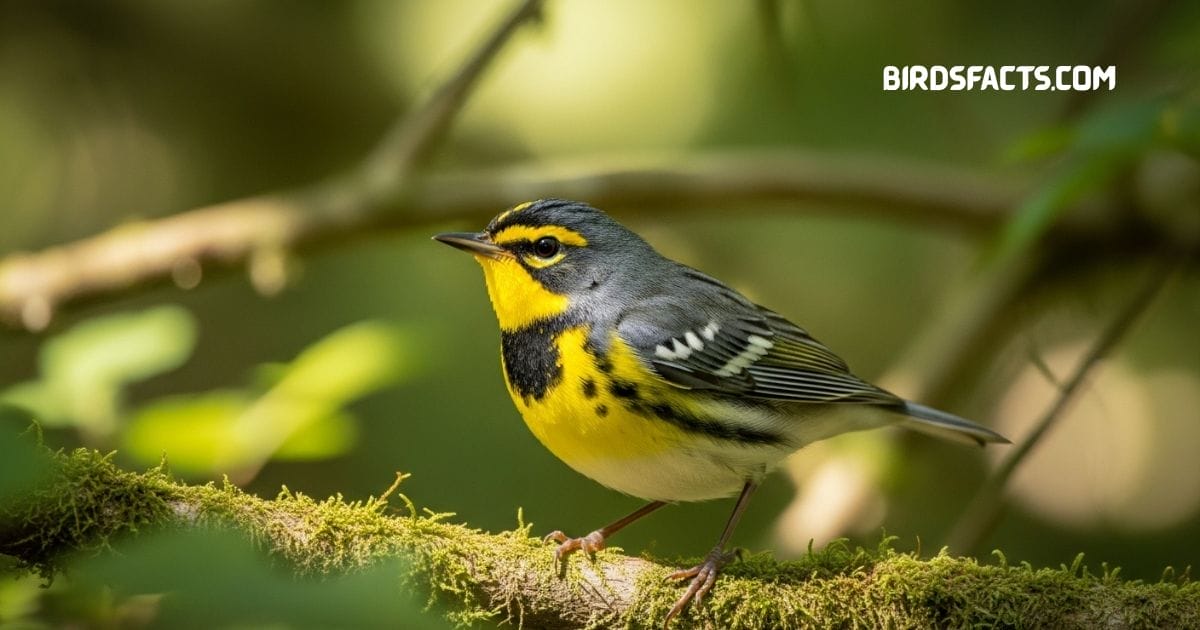
Canada warbler perched on branch with gray back yellow underparts and black necklace markings
The Canada Warbler Is A True Jewel Of The Forest Known For Its Distinctive Necklace Of Dark Streaks Across A Bright Yellow Chest. Among Small Yellow Birds It Stands Out For Its Graceful Movements And Unique Markings. Unlike Some Other Warblers That Stay In One Place This Species Is A Long Distance Migrant Breeding In Canada And The Northern United States Before Traveling All The Way To South America For Winter. Spotting One During Spring Migration Feels Like A Rare Treat As Their Numbers Have Declined Due To Habitat Loss. They Are Often Seen Flitting Through Dense Undergrowth Making Them Challenging To Photograph But Rewarding To Observe.
Behaviorally Canada Warblers Are Very Active And Agile Constantly Moving While Foraging For Insects. Their Song Is A Lively Series Of Notes That Helps Birders Identify Them Even When Hidden In Foliage. Because They Rely Heavily On Healthy Forests Conservation Groups Keep A Close Eye On Their Populations. For Bird Watchers Who Appreciate Small Yellow Birds The Canada Warbler Represents Both Beauty And Fragility. Watching These Small Yellow Birds Dancing Through The Green Canopy Is Like Seeing Sunlight Flicker Through The Trees.
| Facts | Detail |
|---|---|
| Range | Breeds In Canada And Northern United States / Winters In South America |
| Key Fact | Bright Yellow Chest With Dark Necklace Of Streaks |
| Plumage | Gray Upperparts Bright Yellow Underparts With Distinctive Necklace |
| Behavior | Very Active And Hard To Spot Among Dense Vegetation |
| Status | Populations Declining Due To Habitat Loss |
Cape May Warbler
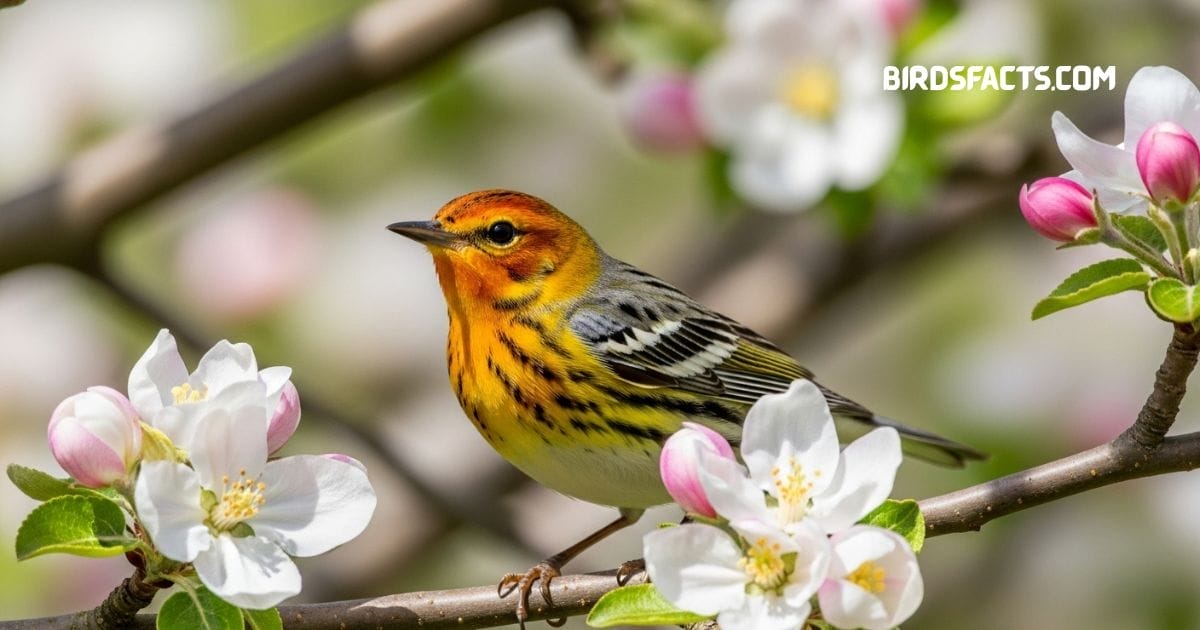
Cape May warbler perched on tree branch with streaked yellow underparts and chestnut cheek patch
The Cape May Warbler Is One Of The Most Stunning Small Yellow Birds You Can Encounter During Spring Migration. Males Feature A Bright Yellow Chest Streaked With Black An Orange Cheek Patch And Bold Markings That Make Them Stand Out Even Among Other Colorful Warblers. This Bird Breeds In Northern Spruce Forests And Spends Winters In The Caribbean Making It A Long Distance Traveler. During Migration They Are Often Seen In Blooming Trees Sipping Nectar Or Hunting Insects.
Unlike Many Other Small Yellow Birds The Cape May Has A Semi Tubular Tongue That Allows It To Feed On Flower Nectar Similar To Hummingbirds. This Adaptation Comes In Handy When Insects Are Scarce Giving Them An Advantage In Different Habitats. Birders Often Note Their Preference For Spruce Budworm Caterpillars Which Can Sometimes Make Them Appear In Huge Numbers When Outbreaks Occur. Their Sharp High Pitched Song Is Also A Helpful Identification Clue For Keen Listeners. Watching These Small Yellow Birds Flutter Among Blossoms Adds A Touch Of Tropical Beauty To Any Spring Morning.
| Facts | Detail |
|---|---|
| Range | Breeds In Northern Spruce Forests / Winters In The Caribbean |
| Key Fact | Yellow Chest With Black Streaks And Orange Cheek Patch |
| Plumage | Yellow Underparts With Black Streaks And Olive Upperparts |
| Behavior | Feeds Heavily On Spruce Budworm Caterpillars |
| Adaptation | Special Tubular Tongue For Nectar Feeding |
Citrine Wagtail
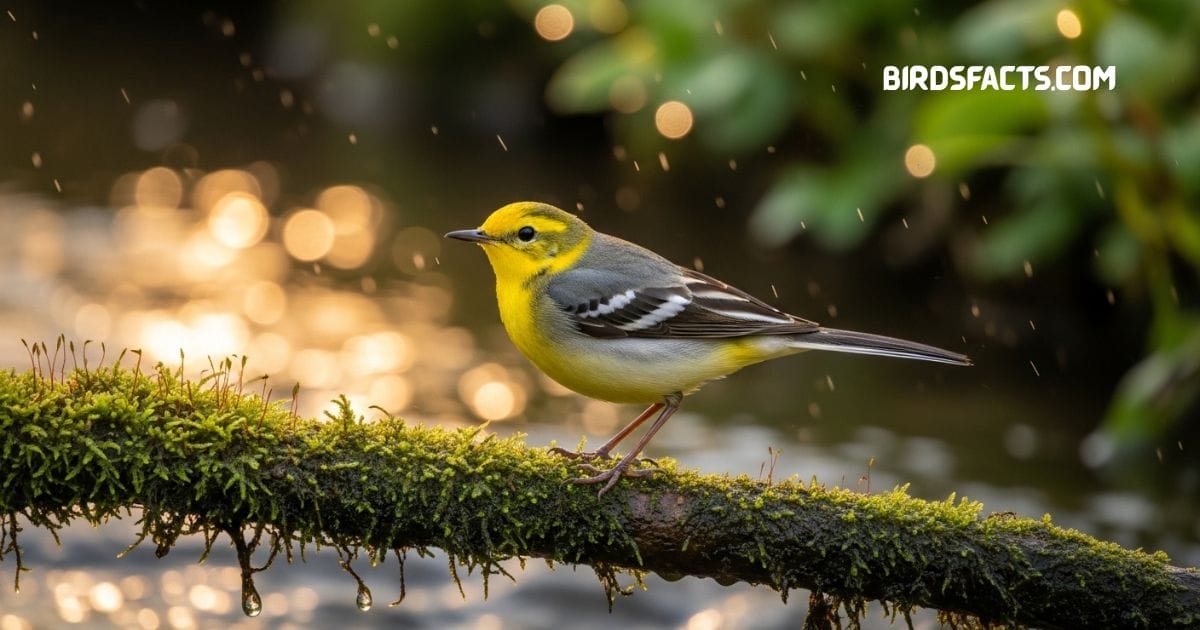
Citrine wagtail standing near water with bright yellow head gray wings and slender tail
The Citrine Wagtail Is A Rare But Eye Catching Member Of The Small Yellow Birds Family Especially In Europe And Asia Where It Is More Commonly Found. Its Body Glows With A Lemon Yellow Face And Underparts Contrasted With Gray Wings And Back. True To Its Name The Wagtail Constantly Pumps Its Long Tail Up And Down As It Forages Often Near Wetlands And Riverbanks. While Sightings In North America Are Extremely Rare Vagrants Occasionally Appear And Excite Birders.
Their Behavior Is Charming To Watch As They Dart Along The Water’s Edge In Search Of Insects. These Small Yellow Birds Are Ground Feeders Preferring Open Spaces Where They Can Move Quickly And Spot Prey. In Breeding Plumage The Male’s Golden Yellow Head Becomes Especially Striking Making Them Hard To Miss In Their Preferred Habitats. For Bird Watchers Around The World Seeing One Of These Graceful Small Yellow Birds Outside Its Normal Range Is A Memorable Highlight Worth Celebrating.
| Facts | Detail |
|---|---|
| Range | Common In Asia / Europe / Rare Vagrant In North America |
| Key Fact | Yellow Face And Belly With Gray Back And Wings |
| Plumage | Yellow Underparts With Gray Upperparts And Distinctive Tail Wagging |
| Behavior | Constantly Wags Its Tail When Walking |
| Habitat | Prefers Wetlands / Riverbanks / Grassy Fields |
Common Yellowthroat
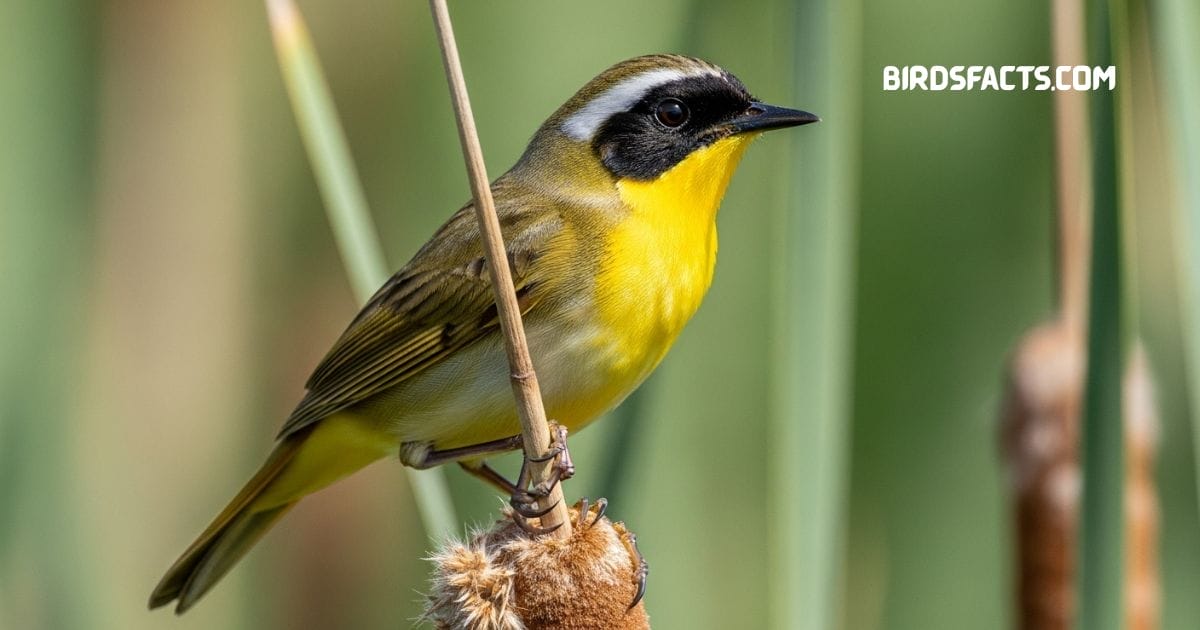
Common yellowthroat perched on reed with olive back yellow throat and black mask
The Common Yellow Throat Is One Of The Most Familiar Small Yellow Birds In North America Easily Recognized By The Males Bold Black Mask Across The Face. Both Sexes Have Bright Yellow Throats And Bellies Though Females Lack The Striking Mask. These Warblers Prefer Wetlands Marshes And Shrubby Areas Making Them A Common Sight During Breeding Season. Their Witchety Witchety Witchety Song Is A Classic Sound Of Spring.
Because They Often Stay Low In Thick Vegetation Common Yellow Throats Can Be More Easily Heard Than Seen. They Are Insect Eaters Constantly Hopping And Flicking Their Tails As They Forage. Despite Their Wide Distribution They Can Be Surprisingly Secretive Giving Birders Fleeting Glimpses. Among Small Yellow Birds They Stand Out For Their Adaptability To Various Habitats Making Them One Of The Most Widespread Warblers In North America. Watching These Small Yellow Birds Dart Through Marsh Grasses Is A Joy For Anyone Who Loves The Hidden Beauty Of Nature.
| Facts | Detail |
|---|---|
| Range | Found In Wetlands / Marshes / Shrubby Areas |
| Key Fact | Males Have A Bold Black Mask While Females Lack It |
| Plumage | Bright Yellow Throat And Belly With Olive Back |
| Behavior | Song Witchety-Witchety-Witchety |
| Habitat | Wetlands Marshes And Dense Vegetation |
Female American Redstart
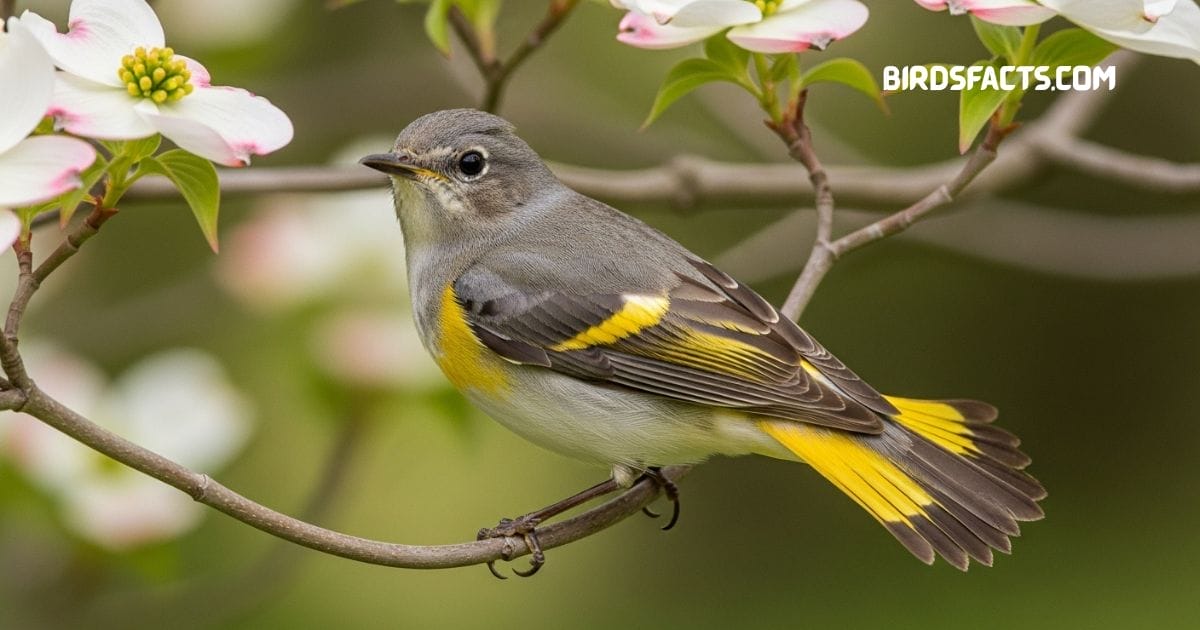
Female American redstart perched on branch with gray head yellow sides and white belly
The Female American Redstart Is Often Overshadowed By The Flashy Black And Orange Males But Her Soft Beauty Is Just As Worth Noticing. Among Small Yellow Birds She Stands Out For Her Graceful Movements And Subtle Glow. She Has Grayish Plumage With Bright Yellow Patches On Her Wings Sides And Tail Giving Her A More Gentle Charm. Like The Males Females Are Very Active Foragers Constantly Fanning Their Tails To Flush Insects From Foliage. Their Lively Behavior Makes Them A Delight To Watch In Wooded Habitats.
Although Not As Striking As The Males Female Redstarts Play A Vital Role In Raising Young Often Taking The Lead In Caring For Chicks. They Prefer Forests And Shrubby Edges Where Insects Are Abundant. Observing These Small Yellow Birds Darting Through Branches Reminds Bird Lovers That Beauty Lies In Motion And Detail. For Many Birders Identifying The Females Of These Small Yellow Birds Feels Like Unlocking A Hidden Layer Of Nature’s Artistry.
| Facts | Detail |
|---|---|
| Range | Found In Woodlands And Shrubby Edges Across North America |
| Key Fact | Gray Plumage With Yellow Patches On Wings Sides And Tail |
| Plumage | Dull Gray Overall With Bright Yellow Highlights |
| Behavior | Constantly Fans Tail To Flush Insects |
| Role | Important Caregiver During Breeding Season |
Golden Tanager
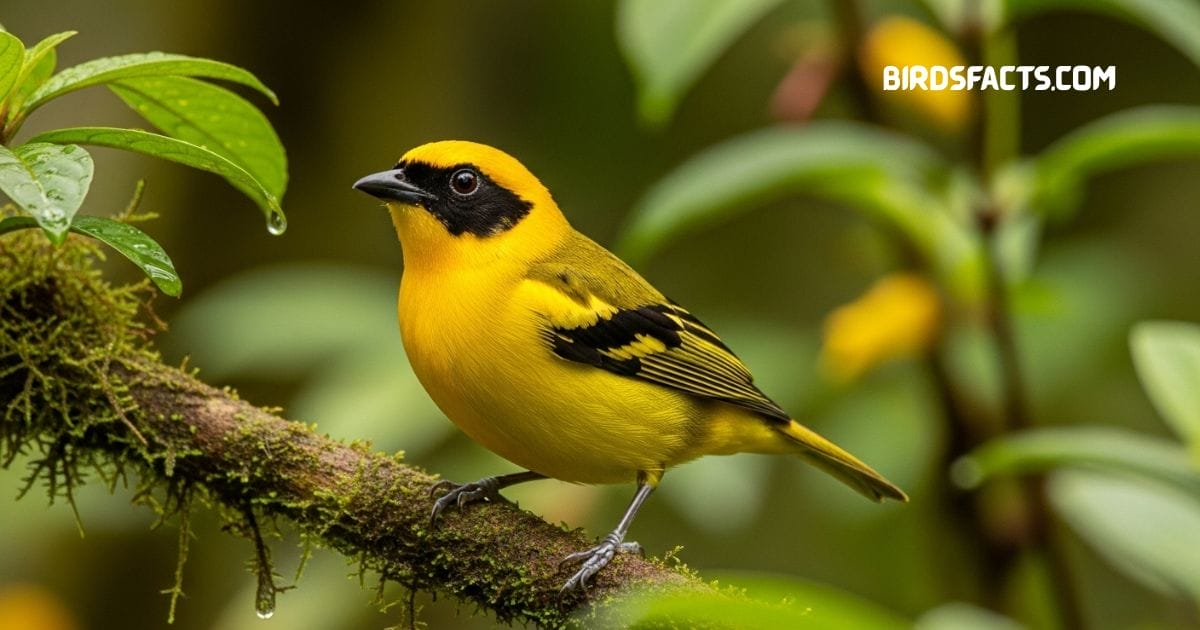
Golden tanager perched on branch with bright golden yellow plumage and contrasting black wings
The Golden Tanager Is One Of The Most Striking Small Yellow Birds Native To The Cloud Forests Of Central And South America. As Its Name Suggests Its Body Shines In Brilliant Golden Yellow Plumage Contrasted With Black Wings And A Streaked Back. Its Rich Coloring Makes It Look Like A Drop Of Sunlight Perched Among The Greenery. These Birds Are Often Found In Flocks Sometimes Mixing With Other Tanager Species While Foraging For Fruit And Insects.
Their Diet Consists Largely Of Berries Seeds And Insects Making Them Important Members Of The Forest Ecosystem. Among Small Yellow Birds They Are Especially Popular With Ecotourists Exploring The Andes Where They Can Be Spotted In Mid Elevation Forests. Their Soft Twittering Calls Blend Into The Busy Soundscape Of The Tropics But Once Seen Their Beauty Is Unforgettable. For Bird Watchers Around The World Seeing These Small Yellow Birds In The Misty Canopy Feels Like Finding Gold Hidden In The Trees.
| Facts | Detail |
|---|---|
| Range | Found In Central America / South America Cloud Forests |
| Key Fact | Brilliant Golden Yellow Plumage With Black Wings And Streaks |
| Plumage | Golden Yellow Body With Contrasting Black Markings |
| Behavior | Often Forages In Mixed Flocks With Other Tanagers |
| Diet | Eats Fruits Berries And Insects |
Golden-Headed Manakin
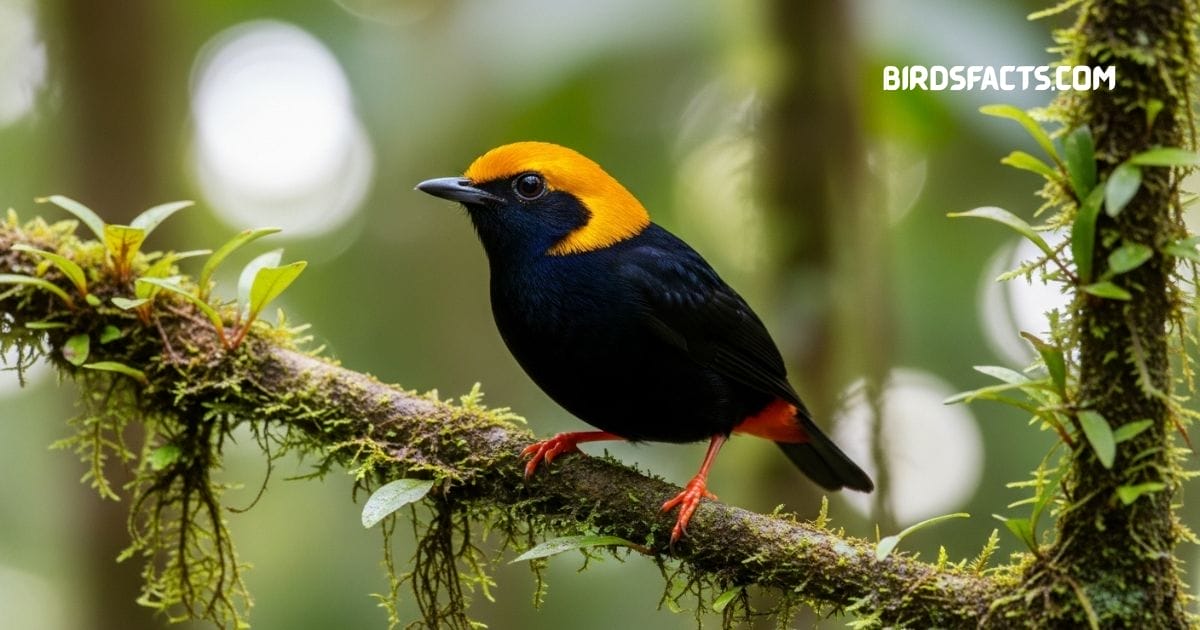
Golden-headed manakin perched on branch with bright golden head black body and short tail
The Golden Headed Manakin Is One Of The Most Striking Small Yellow Birds Found In The Tropical Forests Of Central And South America. Its Vibrant Golden Yellow Head Contrasted With A Glossy Black Body Makes It Instantly Recognizable. This Tiny Bird Is Best Known For Its Unusual Courtship Displays Where Males Gather In Groups And Perform Quick Acrobatic Jumps And Buzzing Sounds To Impress Females. These Energetic Performances Make The Manakin One Of The Most Entertaining Birds To Watch In The Tropics.
In Addition To Its Fascinating Displays The Golden Headed Manakin Thrives In Forest Habitats Rich With Fruiting Trees. Like Many Other Small Yellow Birds It Plays A Vital Role In Spreading Seeds And Supporting The Balance Of The Ecosystem. Although Shy Outside Their Displays They Are A Beloved Sight For Birdwatchers Exploring The Tropics. Seeing These Small Yellow Birds Glimmering In Dappled Forest Light Feels Like Watching Sparks Of Gold Dancing In The Shade.
| Facts | Detail |
|---|---|
| Range | Found In Central America / South America Tropical Forests |
| Key Fact | Black Body With Bright Golden Yellow Head |
| Plumage | Glossy Black Plumage With Distinctive Golden Head |
| Behavior | Famous For Elaborate Courtship Dances In Leks |
| Diet | Eats Fruits And Acts As Important Seed Disperser |
Grey Wagtail

Grey wagtail standing near stream with grey back yellow underparts and long black tail
The Grey Wagtail Is One Of The Most Graceful Small Yellow Birds Found Across Europe And Parts Of Asia. Its Slender Body Gray Upperparts And Bright Yellow Belly Create A Beautiful Contrast As It Moves Along Riverbanks And Lakeshores. Its Long Tail Which It Constantly Wags Is A Signature Feature That Makes It Easy To Identify. During Breeding Season Males Display Even Deeper Yellow Plumage On Their Underparts Making Them Stand Out Even More.
Unlike Some Other Small Yellow Birds That Migrate Long Distances Grey Wagtails Often Stay Close To Their Breeding Grounds Moving Only Short Distances In Winter. They Are Skilled Insect Hunters Frequently Darting Over Water To Catch Prey With Remarkable Precision. Watching These Small Yellow Birds Wag Their Tails Along Sparkling Streams Is A Peaceful Sight That Captures The Beauty Of Nature In Motion.
| Facts | Detail |
|---|---|
| Range | Prefers Rivers / Lakes / Streams For Feeding |
| Key Fact | Gray Upperparts With Bright Yellow Underparts |
| Plumage | Gray Back With Bright Yellow Belly And Long Tail |
| Behavior | Constantly Wags Long Tail |
| Diet | Hunts Insects Both On The Ground And In Flight |
Grey-Crowned Yellowthroat

Grey-crowned yellowthroat perched on reed with olive body yellow throat and gray crown
The Grey Crowned Yellowthroat Is One Of The Most Distinctive Small Yellow Birds Found Across Central And South America. True To Its Name It Has A Gray Crown And Olive Back With A Bright Yellow Throat And Underparts That Shine In Sunlight. Males Often Sing From Open Perches Making Them Easier To Spot Than Some Other Warblers. Their Sweet Rising Song Carries Beautifully Across Grasslands And Fields.
This Species Thrives In Grasslands Scrub And Farmland Areas Where Dense Vegetation Provides Cover. Unlike Many Migratory Small Yellow Birds Grey Crowned Yellowthroats Are Mostly Resident Year Round. Their Adaptability Allows Them To Survive In A Variety Of Habitats Though They Still Depend On Healthy Grasslands To Thrive. For Bird Watchers In Central America Hearing These Small Yellow Birds Sing Cheerfully From The Tall Grass Is A Simple Yet Joyful Experience.
| Facts | Detail |
|---|---|
| Range | Found In Central America / South America |
| Key Fact | Yellow Underparts With Gray Crown And Olive Back |
| Plumage | Yellow Belly Gray Crown And Olive Green Upperparts |
| Behavior | Sweet Rising Song Commonly Heard From Perches |
| Habitat | Prefers Grasslands And Scrubby Habitats |
Hooded Warbler
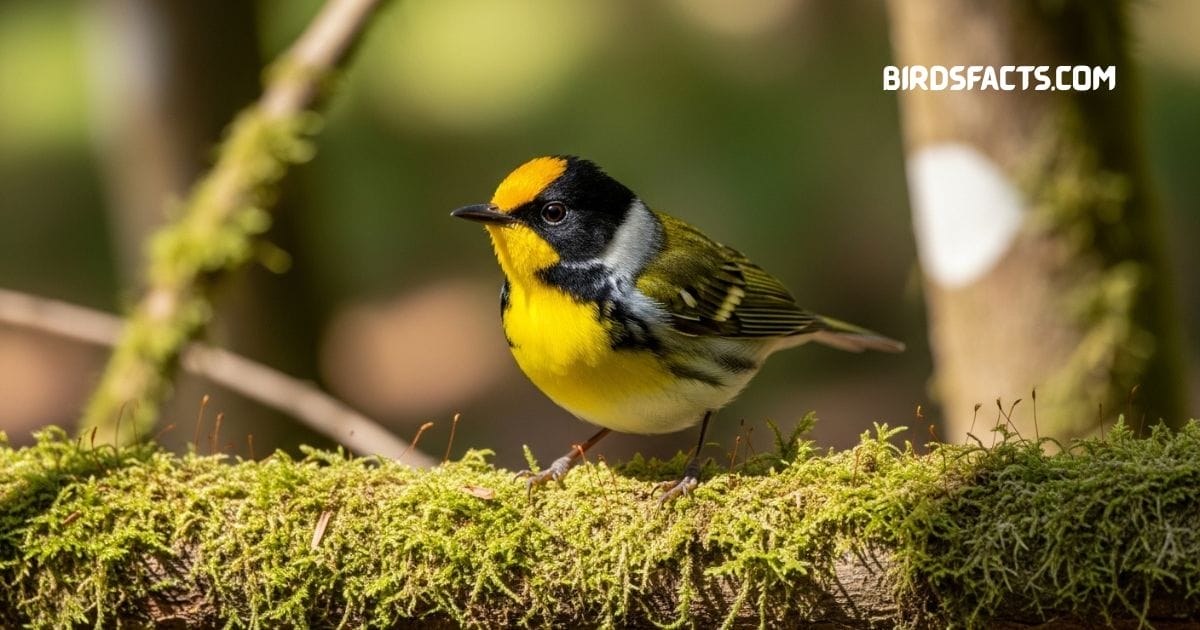
Hooded warbler perched on branch with olive back yellow underparts and black hood
The Hooded Warbler Is One Of The Most Recognizable Small Yellow Birds In North America Easily Identified By Its Bright Yellow Face Framed With A Bold Black Hood. Females And Young Birds Are Less Dramatic Lacking The Full Hood But Still Display The Same Warm Yellow Glow. They Prefer Dense Understory Habitats In Forests Where Their Quick Flitting Movements Make Them Both Exciting And Challenging To Spot. Their Clear Ringing Song Ta Wit Ta Wit Tee Yo Is One Of The Classic Sounds Of Spring.
This Species Breeds Mainly In The Eastern United States And Migrates To Central America And The Caribbean For Winter. Like Many Small Yellow Birds They Are Agile Insect Hunters Often Snatching Prey In Midair Or Picking It From Leaves. Their Bold Plumage And Constant Energy Make Them A Favorite Among Birdwatchers. Seeing These Small Yellow Birds Flashing Brightly Through The Forest Is A Reward That Brings Every Spring Morning To Life.
| Facts | Detail |
|---|---|
| Range | Found In Eastern United States Forests / Winters In Central America And The Caribbean |
| Key Fact | Bright Yellow Face With Bold Black Hood In Males |
| Plumage | Yellow Underparts Greenish Back And Distinctive Black Hood In Males |
| Behavior | Known For Its Clear Ta-Wit Ta-Wit Tee-Yo Song |
| Migration | Migrates To Central America And The Caribbean |
Lesser Goldfinch
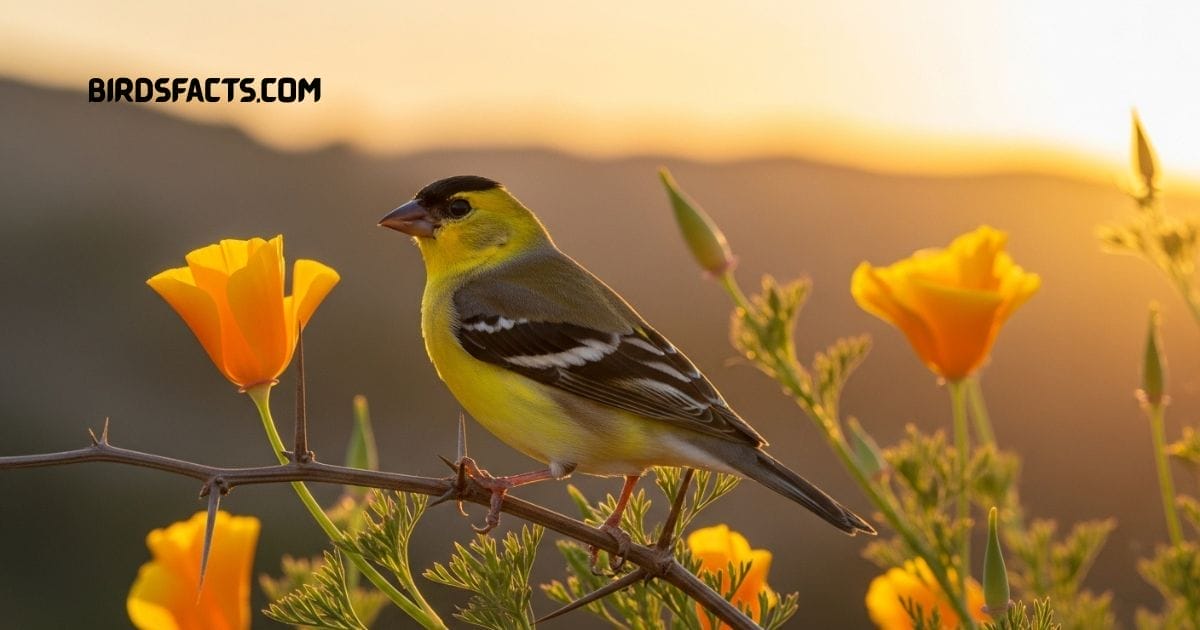
Lesser goldfinch perched on branch with black cap yellow underparts and greenish back
The Lesser Goldfinch Is One Of The Most Charming Small Yellow Birds Found Across The Western And Southwestern United States Extending Into Mexico And Central America. Males Display Brilliant Yellow Underparts With Black Backs While Some Populations In The Southwest Show Greenish Shades. Females Are Paler But Still Carry The Same Cheerful Yellow Glow. This Species Is Highly Social Often Forming Flocks That Feed On Seeds In Open Fields And Meadows.
Their Diet Consists Mainly Of Sunflower Seeds Dandelions And Other Weedy Plants Making Them Frequent Visitors To Backyard Feeders. Like Many Small Yellow Birds They Have A Sweet Canary Like Song That Adds Music To Warm Days. Their Adaptability To Suburban Areas Has Helped Their Populations Stay Strong Thriving In Parks Gardens And Farmland Edges. Watching These Small Yellow Birds Bounce And Flutter Across Meadows Is A Simple Joy That Brightens Any Birdwatchers Day.
| Facts | Detail |
|---|---|
| Range | Found In Western United States Down Through Central America |
| Key Fact | Males Have Yellow Underparts With Black Or Greenish Backs |
| Plumage | Bright Yellow Belly With Contrasting Dark Back |
| Behavior | Frequently Forms Flocks In Open Habitats |
| Song | Sweet Canary-Like Song |
Magnolia Warbler
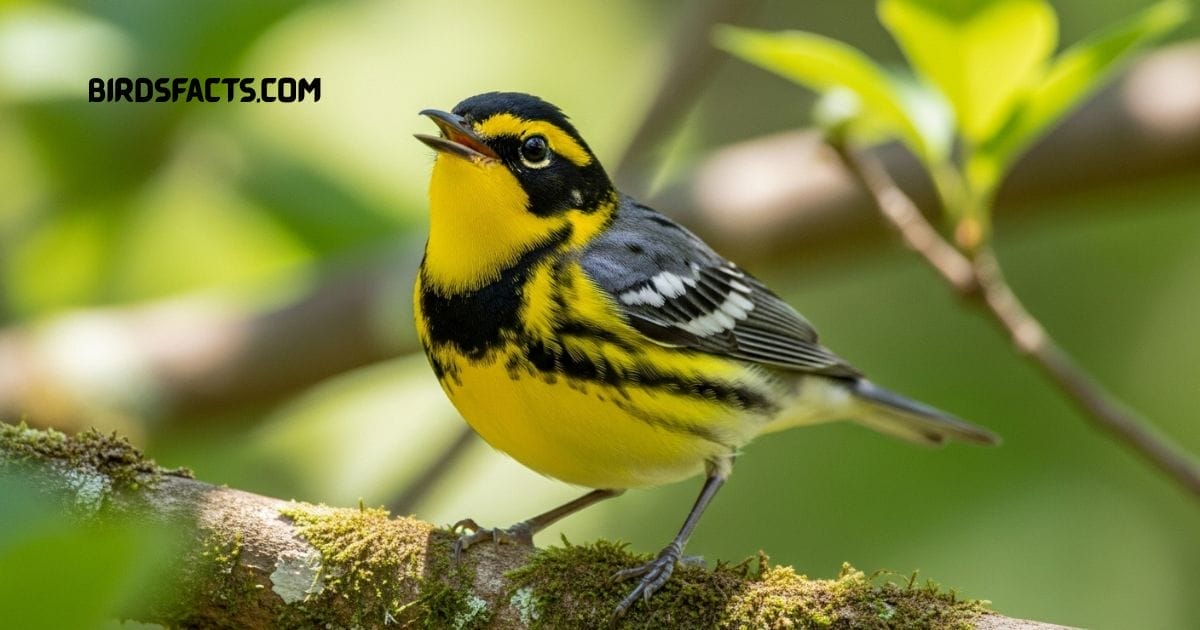
Magnolia warbler perched on branch with black streaked yellow underparts and gray back
The Magnolia Warbler Is One Of The Most Eye Catching Small Yellow Birds In North America With Its Necklace Of Bold Black Streaks Across A Yellow Chest. Despite The Name It Is Not Closely Tied To Magnolia Trees The Bird Was Simply First Discovered In One. This Warbler Is A Long Distance Migrant Breeding In Canada And The Northern United States Before Traveling To Central America And The Caribbean For Winter. Their Bright Plumage And Distinctive Pattern Make Them Favorites Among Birdwatchers During Spring Migration.
Magnolia Warblers Forage Actively In The Mid To Upper Canopy Darting Between Branches In Search Of Insects. Among Small Yellow Birds They Are Known For Their Energetic Movements And Clear Contrasting Colors. Their Necklace Of Black Streaks Serves As A Key Identification Mark Helping Birders Separate Them From Similar Species. Seeing These Small Yellow Birds Flicker Through Green Foliage Is Like Watching Tiny Sunbeams Come To Life In The Forest.
| Facts | Detail |
|---|---|
| Range | Long Distance Migrant Between North America And The Tropics |
| Key Fact | Yellow Chest With Bold Black Streak Necklace |
| Plumage | Yellow Underparts With Black Streaks And Gray Upperparts |
| Behavior | Found In Mid To Upper Canopy While Foraging |
| Name | Named After A Magnolia Tree Where It Was First Described |
Nashville Warbler
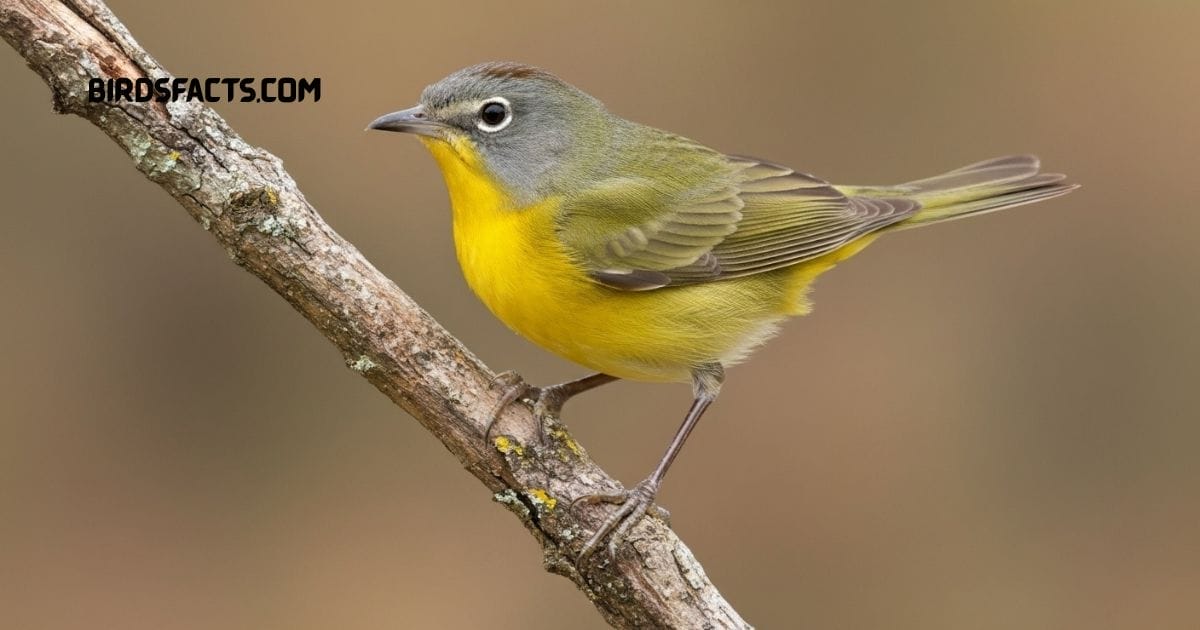
Nashville warbler perched on branch with gray head yellow underparts and olive back
The Nashville Warbler Is One Of The Most Endearing Small Yellow Birds Found Across North America With Its Yellow Belly Gray Head And Distinct White Eye Ring. It Is Commonly Seen During Spring And Fall Migration Moving Swiftly Through Gardens Forest Edges And Shrubby Areas. Despite Its Name It Does Not Breed In Nashville But Was First Discovered There During Migration. These Tiny Travelers Breed In Northern Forests Of The United States And Canada Before Migrating South To Mexico And Central America For Winter.
Their High Pitched Song Made Up Of Clear Two Part Notes Makes Them Easy To Recognize During Breeding Season. Like Many Small Yellow Birds They Forage Low In Shrubs And Small Trees Giving Birders Frequent Glimpses Of Their Restless Movements. Their White Eye Ring Is A Reliable Identification Mark Helping Bird Watchers Spot Them Quickly. Watching These Small Yellow Birds Flit Through Branches Adds A Bright Spark Of Color And Energy To Any Spring Morning.
| Facts | Detail |
|---|---|
| Range | Breeds In Northern United States And Canada / Winters In Mexico And Central America |
| Key Fact | Yellow Belly With Gray Head And White Eye Ring |
| Plumage | Yellow Underparts With Gray Head And Olive Back |
| Behavior | Prefers Low Shrubs And Small Trees For Foraging |
| Song | Two Part High Pitched Note Sequence |
Palm Warbler
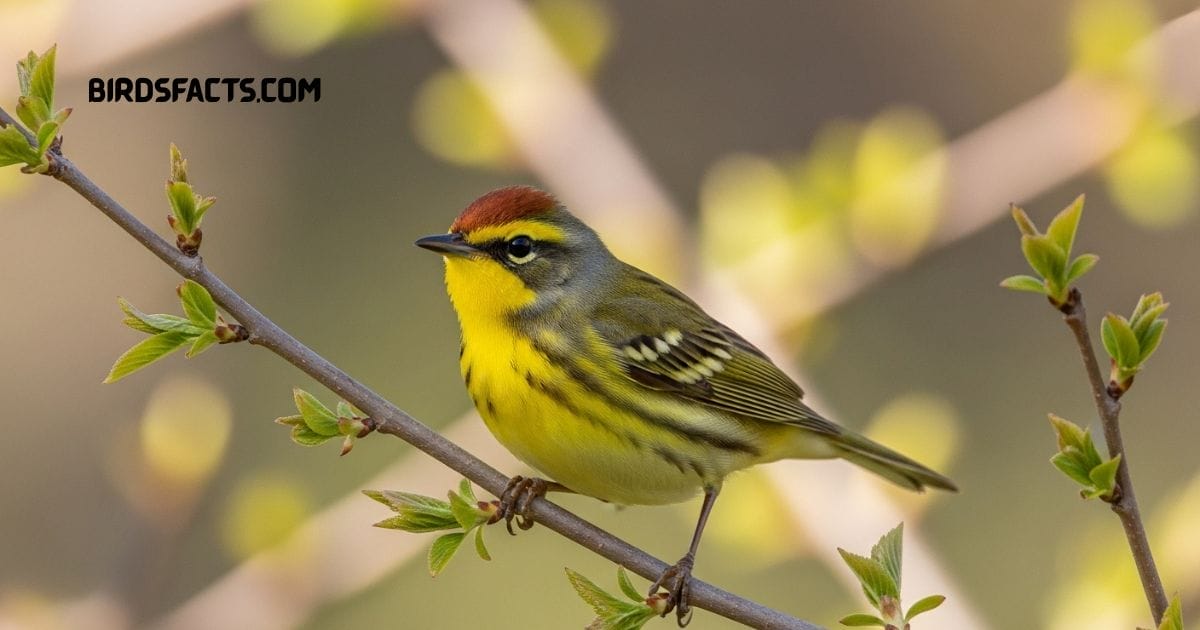
Palm warbler perched on branch with brown streaked back yellow underparts and rusty cap
The Palm Warbler Is One Of The Most Distinctive Small Yellow Birds In North America Known For Its Constant Tail Bobbing Behavior That Instantly Sets It Apart. With A Bright Yellow Belly Chestnut Cap And Streaked Sides It Is A Familiar Sight During Migration Across Open Fields And Shrubby Areas. Unlike Many Other Warblers That Hide In Dense Foliage Palm Warblers Often Stay Close To The Ground Making Them Easier To Watch And Identify. Their Active Nature And Flashing Yellow Plumage Always Catch The Eye.
They Breed In Boggy Spruce Forests Of Canada And Spend Winters In The Southeastern United States And The Caribbean. Like Other Small Yellow Birds They Feed Mostly On Insects But Also Enjoy Berries During Migration. Their Constant Tail Movement Serves As A Signature Gesture Recognizable Even From A Distance. For Bird Watchers Seeing These Small Yellow Birds Hopping Along Trails And Fields Is A Simple Yet Joyful Reminder Of The Beauty Of Seasonal Migration.
| Facts | Detail |
|---|---|
| Range | Breeds In Canadian Bogs / Winters In Southeastern United States And Caribbean |
| Key Fact | Constantly Bobs Tail While Foraging |
| Plumage | Yellow Belly With Chestnut Cap And Brownish Upperparts |
| Behavior | Often Seen On The Ground Or In Low Shrubs |
| Markings | Distinctive Chestnut Cap Especially During Breeding Season |
Pine Warbler
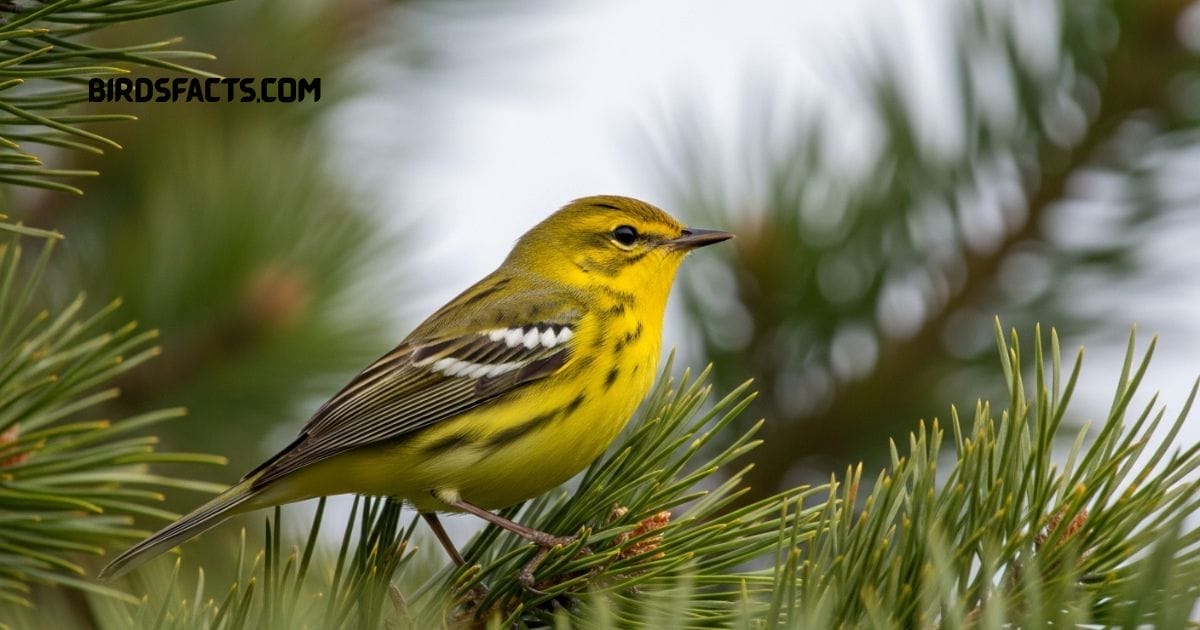
Pine warbler perched on tree branch with olive green back yellow throat and white belly
The Pine Warbler Is One Of The Most Resilient Small Yellow Birds Found Across North America Often Blending Perfectly Into The Pine Forests It Calls Home. Males Display Olive Backs And Bright Yellow Throats And Breasts While Females Show Softer Shades Of The Same Colors. True To Their Name They Are Closely Tied To Pine Woodlands Where They Forage For Insects And Seeds. Unlike Many Other Warblers Pine Warblers Often Visit Backyard Feeders Especially Those Offering Suet Mealworms Or Sunflower Seeds.
Their Song Is A Clear Steady Trill Similar To A Chipping Sparrow Yet More Melodic And Calm. Like Other Small Yellow Birds They Are Adaptable And Resourceful Able To Thrive Even In The Chill Of Winter Thanks To Their Ability To Digest Seeds. Their Regular Visits To Feeders Bring Joy To Bird Watchers Throughout The Year. Seeing These Small Yellow Birds Flitting Among Pine Branches Reminds Nature Lovers How Beauty Can Thrive Even In The Simplest Forest Corners.
| Facts | Detail |
|---|---|
| Range | Strongly Associated With Pine Forests In Eastern North America |
| Key Fact | Olive Back With Bright Yellow Throat And Chest |
| Plumage | Olive Green Upperparts With Yellow Throat And Chest |
| Behavior | Often Seen Foraging High In Pine Trees |
| Diet | One Of The Few Seed Eating Warblers |
| Song | Steady Musical Trill |
Prothonotary Warbler
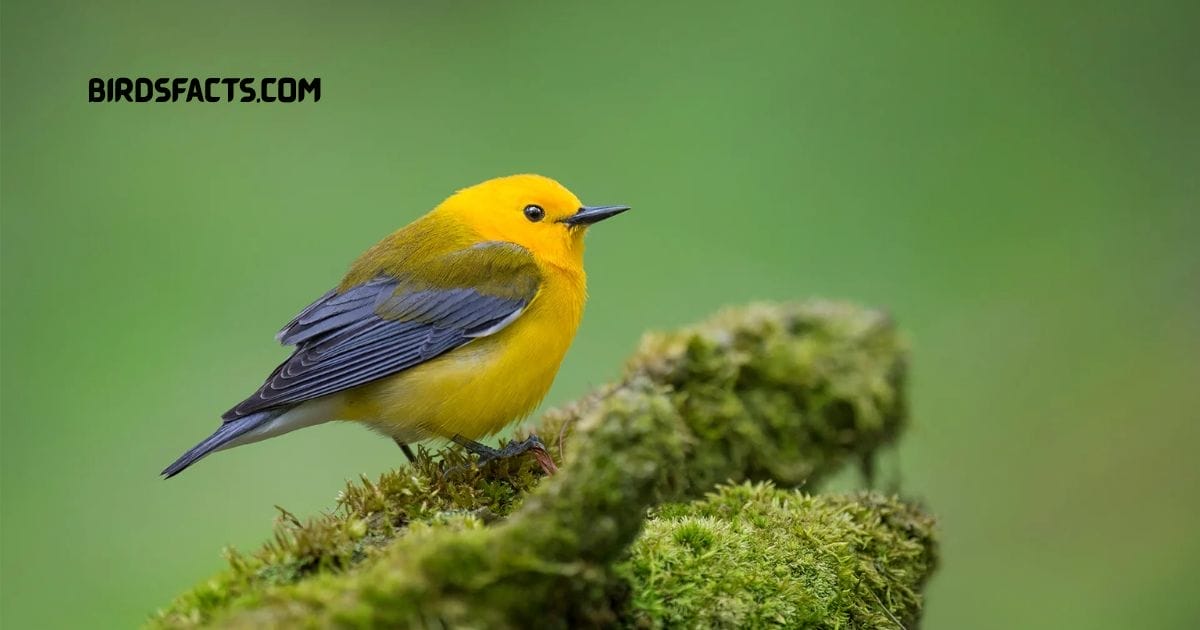
Prothonotary warbler perched on branch with bright yellow body blue gray wings and black bill
The Prothonotary Warbler Is One Of The Most Dazzling Small Yellow Birds In North America With Bright Golden Yellow Plumage That Glows Like A Lantern In Forested Wetlands. Unlike Most Warblers That Stay In Shrubs Or Treetops This Species Prefers Swampy Areas Nesting In Cavities Along Rivers And Flooded Forests. Its Dependence On Wet Habitats Makes It A Unique And Specialized Member Of The Warbler Family. For Bird Watchers Spotting One Of These Small Yellow Birds Shining In The Dim Light Of The Woods Is An Unforgettable Experience.
Their Song Is A Loud Ringing Sweet Sweet Sweet Sweet That Echoes Across Marshes And Rivers. These Warblers Are Cavity Nesters Often Using Old Woodpecker Holes Or Nest Boxes Placed In Wetland Areas. Like Many Other Small Yellow Birds They Have Faced Challenges From Habitat Loss But Conservation Efforts Have Helped Keep Their Populations Steady. Seeing One Perched Over Still Water Brings A Sense Of Warmth And Wonder To Any Birding Trip.
| Facts | Detail |
|---|---|
| Range | Found In Swampy Wetlands And Flooded Forests |
| Key Fact | Bright Golden Yellow Plumage |
| Plumage | Golden Yellow Body With Blue Gray Wings And Tail |
| Behavior | Loud Ringing Sweet Sweet Sweet Song |
| Nesting | Nests In Cavities Often Near Water |
Saffron Finch
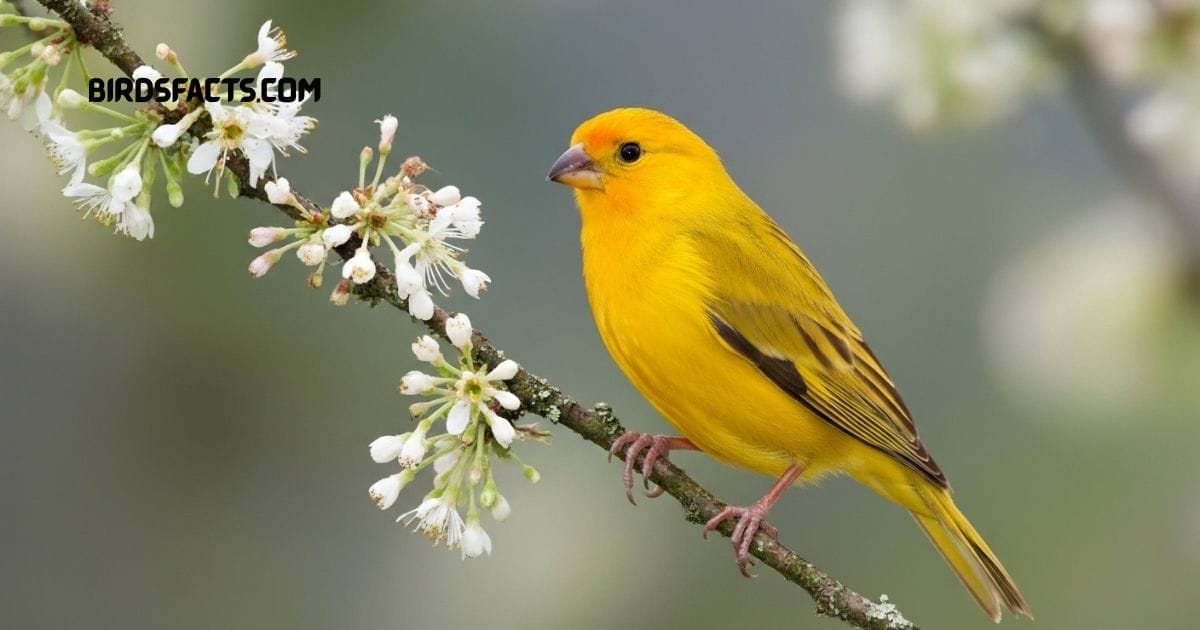
Saffron finch perched on branch with bright yellow plumage and orange crown
The Saffron Finch Is One Of The Most Delightful Small Yellow Birds Native To South America But Also Found In Other Regions Including Hawaii. Males Shine In Bright Golden Yellow While Females Are Softer In Tone With Gentle Brown Streaks. These Finches Are Highly Social Often Gathering In Flocks Across Open Fields Gardens And Farmlands. Their Sweet Warbling Songs Fill The Air Bringing Warmth And Cheer To Any Landscape.
Although They Resemble Canaries They Are Actually More Closely Related To Tanagers. Like Many Small Yellow Birds They Have Adapted Well To Suburban Areas Especially In Places Where They Have Been Introduced Such As Hawaii. Their Love For Seeds And Grains Makes Them Common Visitors To Feeders Where Their Color And Energy Instantly Stand Out. Watching These Small Yellow Birds Glow In The Sunlight Feels Like Witnessing Pure Joy In Motion.
| Facts | Detail |
|---|---|
| Range | Native To South America / Introduced To Hawaii |
| Key Fact | Bright Golden Yellow Plumage In Males |
| Plumage | Golden Yellow Body With Darker Streaks On Back |
| Behavior | Social Species Often Found In Flocks |
| Diet | Eats Seeds And Grains / Visits Feeders |
Townsend Warbler
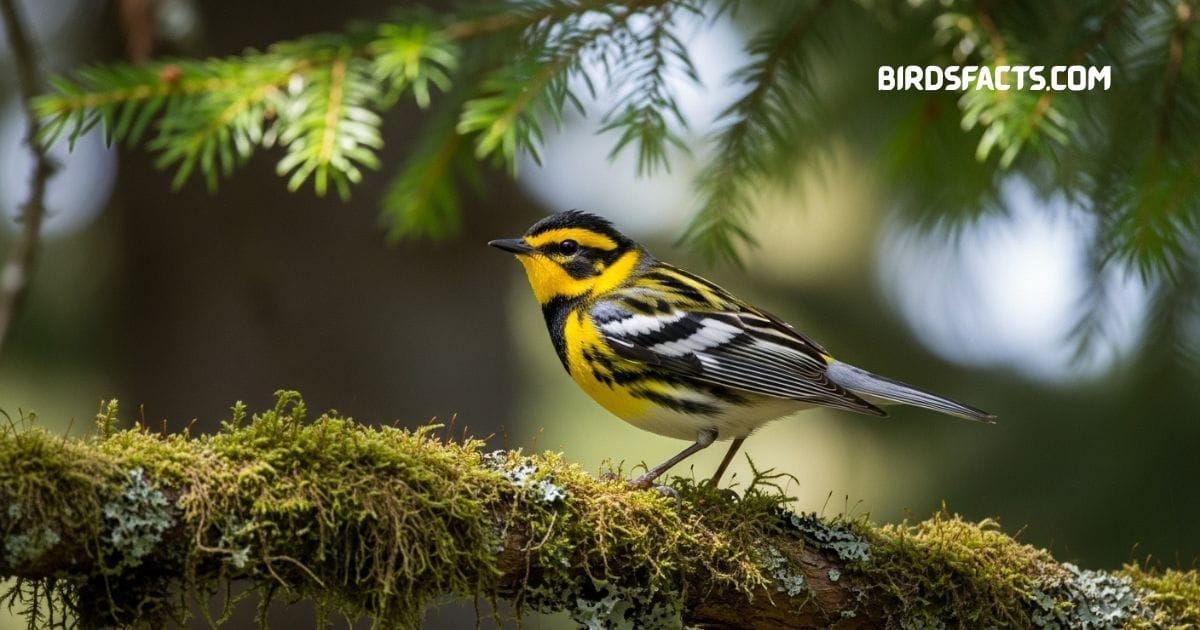
Townsend warbler perched on branch with yellow face black mask and greenish back
The Townsend Warbler Is One Of The Most Distinctive Small Yellow Birds Found In Western North America Easily Recognized By Its Bright Yellow Face And Bold Black Markings. With Olive Green On Its Back And Sharp Facial Stripes It Stands Out Among Migrating Warblers. This Species Breeds In Coniferous Forests From Alaska To The Pacific Northwest And Travels As Far South As Central America For Winter. Their Clear High Pitched Songs And Vivid Colors Make Them Favorites Among Birdwatchers During Spring And Fall Migration.
These Energetic Birds Forage In The Upper Branches Of Trees Often Joining Mixed Flocks Of Chickadees And Other Small Yellow Birds While Searching For Insects. They Skillfully Glean Bugs From Needles And Leaves And Occasionally Hover Briefly To Catch Prey Midair. Their Preference For High Perches Means Spotting Them Requires Patience And Focus. For Many Birders The Glimpse Of These Small Yellow Birds With Their Bright Faces And Striking Masks Is A Reward Worth The Wait.
| Facts | Detail |
|---|---|
| Range | Breeds In Western Coniferous Forests / Winters In Central America |
| Key Fact | Yellow Face With Bold Black Stripes |
| Plumage | Yellow Underparts Greenish Back And Black Facial Stripes |
| Behavior | Often Joins Mixed Flocks In Treetops |
| Migration | Migrates To Central America In Winter |
Verdin
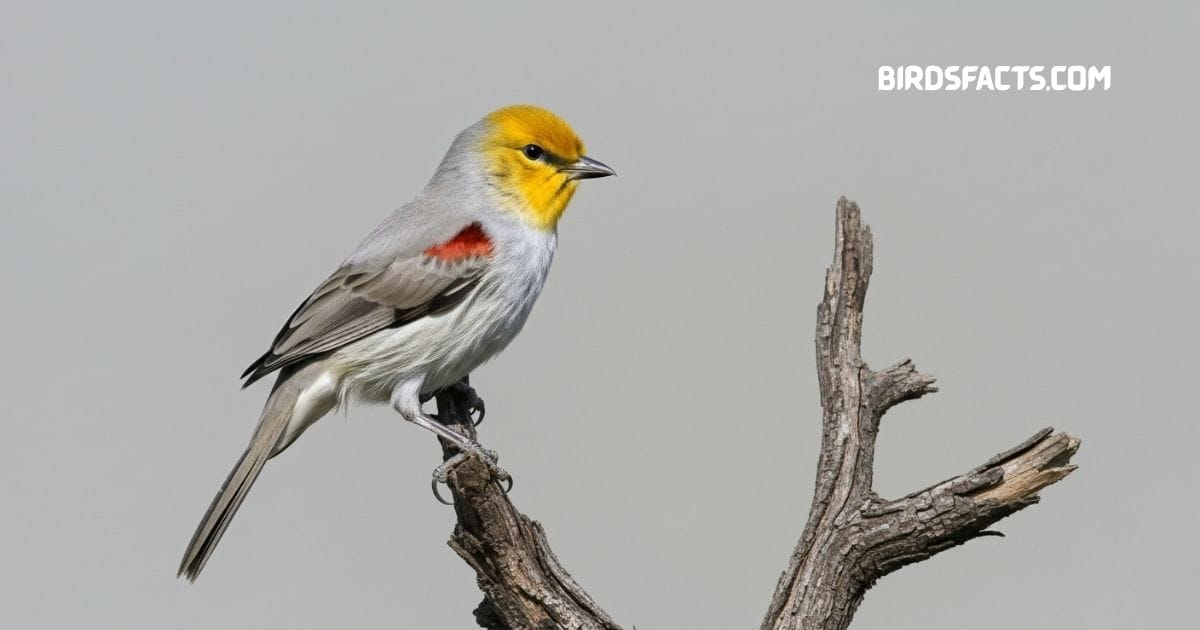
Verdin perched on branch with gray body yellow head and small sharp bill
The Verdin Is One Of The Most Resilient Small Yellow Birds Found In The Arid Regions Of The Southwestern United States And Northern Mexico. It Is Easily Recognized By Its Tiny Size Gray Body And Bright Yellow Face That Shines Against The Desert Landscape. Unlike Many Songbirds That Avoid Dry Climates Verdins Thrive In Harsh Environments Where Water And Shade Are Scarce. Their Bright Appearance And Constant Activity Make Them Fascinating To Watch Among Desert Shrubs.
One Of The Most Remarkable Traits Of These Small Yellow Birds Is Their Nest Building Skill. Verdins Construct Large Spherical Nests From Twigs And Line Them With Softer Materials Creating Safe Shelters For Both Breeding And Roosting. They Feed Mostly On Insects But Will Also Take Nectar And Fruit When Available. Watching These Small Yellow Birds Move Swiftly Through Thorny Bushes Reminds Bird Lovers Of Nature’s Incredible Ability To Adapt And Endure Even In The Hottest Deserts.
| Facts | Detail |
|---|---|
| Range | Native To Southwestern United States And Northern Mexico |
| Key Fact | Small Desert Bird With Bright Yellow Face |
| Plumage | Gray Body With Distinctive Yellow Face |
| Behavior | Builds Large Spherical Twig Nests |
| Diet | Eats Insects Nectar And Fruits |
White-Eyed Vireo
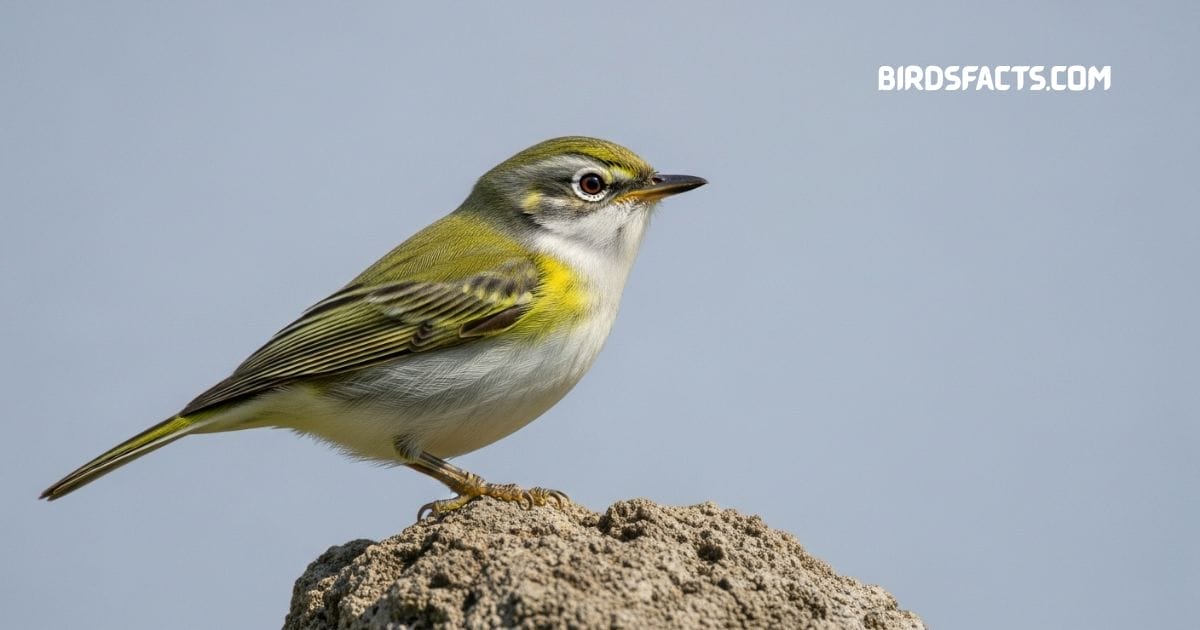
White-eyed vireo perched on branch with olive back yellow sides and white eye ring
The White Eyed Vireo Is One Of The Most Vocal Small Yellow Birds In The Eastern And Southeastern United States. It Is Easily Recognized By Its Sharp Yellow Flanks And Bright White Eyes Which Give It A Piercing Look Of Alertness. This Lively Songbird Prefers Dense Thickets And Scrubby Fields Where It Stays Hidden While Filling The Air With Its Bold Song. Its Energetic Movements And Distinct Appearance Make It A Favorite Among Birdwatchers Who Love The Challenge Of Spotting Quick Forest Dwellers.
Its Song Sounds Like A String Of Sharp Scolding Notes Making It Unique Among Small Yellow Birds. White Eyed Vireos Hunt For Insects Among Leaves And Branches Moving Swiftly Through Thick Brush. They Are Migratory With Northern Populations Spending Winter In The Southern United States Central America And The Caribbean. Watching These Small Yellow Birds Flash Between Sunlit Branches Brings Life And Sound To Even The Quietest Woodlands.
| Facts | Detail |
|---|---|
| Range | Found In Eastern And Southeastern United States Thickets / Winters In Southern United States And Central America |
| Key Fact | Bright White Eyes With Yellow Flanks |
| Plumage | Olive Green Back Yellow Flanks And Distinctive White Eyes |
| Behavior | Loud Scolding Complex Song |
| Migration | Migrates To Southern United States And Central America |
Wilson’s Warbler
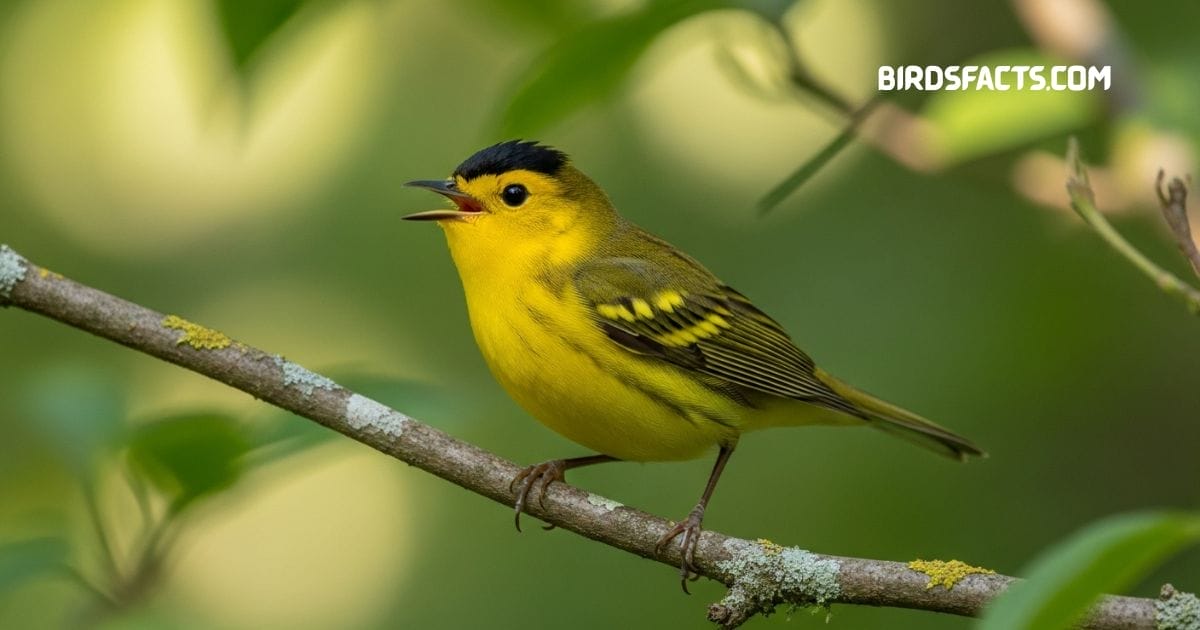
Wilson’s warbler perched on branch with bright yellow body olive back and small black cap
The Wilson’s Warbler Is One Of The Most Adorable Small Yellow Birds Seen During Migration Across North America. Males Wear A Distinct Black Cap That Looks Like A Tiny Hat While Females Show Softer Yellow Tones Without The Full Cap. Their Bright Plumage And Constant Motion Make Them Easy To Spot As They Flit Through Low Shrubs And Along Stream Edges Searching For Insects. Their Energetic Movements Bring A Sense Of Life And Light To Every Habitat They Visit.
These Small Yellow Birds Breed In Northern Forests And Mountain Regions Often Nesting Close To Water. Their Song Is A Sweet Chattering Trill That Rises And Falls With A Cheerful Rhythm. Because They Often Stay Low Birders Have A Good Chance Of Close Encounters During Spring And Fall Migration. Watching These Small Yellow Birds Bounce Through The Undergrowth Feels Like Seeing Bits Of Sunshine Come Alive In The Trees.
| Facts | Detail |
|---|---|
| Range | Breeds In Northern Forests Often Near Streams / Winters In Central America |
| Key Fact | Small Yellow Warbler With Tiny Black Cap In Males |
| Plumage | Bright Yellow Plumage With Distinctive Black Cap In Males |
| Behavior | Forages Low In Shrubs And Brush |
| Song | Sweet Chattering Trill |
Yellow-Bellied Elaenia

Yellow-bellied elaenia perched on branch with olive upperparts yellow belly and small crest
The Yellow Bellied Elaenia Is One Of The Most Active Small Yellow Birds Found Across Central And South America. Unlike Finches And Warblers This Lively Species Belongs To The Tyrant Flycatcher Family. It Has A Grayish Olive Body A Bright Yellow Belly And A Soft Crest That It Raises When Excited. Though Not As Vivid As Some Other Small Yellow Birds Its Constant Chattering Calls And Quick Movements Make It Easy To Notice In The Wild.
This Bird Is Common In Open Woodlands Gardens And Forest Edges Where It Hunts Insects Midair With Impressive Precision. It Also Enjoys Small Fruits And Berries Adding Variety To Its Diet. The Yellow Bellied Elaenia Is Highly Adaptable Thriving Even Near Human Settlements And Parks. Watching These Small Yellow Birds Flutter Through Sunlit Branches Is A Reminder That Even The Subtlest Colors Can Bring Life And Energy To The Tropics.
| Facts | Detail |
|---|---|
| Range | Found In Central America And South America |
| Key Fact | Gray Olive Body With Yellow Belly And Faint Crest |
| Plumage | Olive Gray Upperparts Yellow Underparts And Small Crest |
| Behavior | Active Flycatcher Frequently Flicking Wings And Tail |
| Diet | Eats Insects And Small Fruits |
Yellow-Bellied Sunbird

Yellow-bellied sunbird perched on branch with bright yellow belly and metallic grYellow-bellied sunbird perched on branch with bright yellow belly and metallic green back
The Yellow Bellied Sunbird Is One Of The Most Dazzling Small Yellow Birds Found Across Asia. Males Shine With Bright Yellow Underparts And Metallic Blue Heads That Sparkle In Sunlight While Females Show Softer Yellow Tones That Are Equally Graceful. Their Long Curved Bills Help Them Sip Nectar From Flowers Much Like Hummingbirds. Their Quick Fluttering Movements And Jewel Like Colors Make Them A Delight To Watch In Gardens And Forest Edges.
These Small Yellow Birds Are Not Only Nectar Feeders But Also Catch Tiny Insects Especially When Raising Their Young. They Move Rapidly From Flower To Flower Rarely Staying Still Their Energy Filling The Air With Life. For Bird Lovers And Photographers Their Presence Brings Beauty To Any Tropical Scene. In Many Cultures These Small Yellow Birds Are Seen As Symbols Of Joy And Vitality Shining Like Living Sunlight Amid The Blossoms.
| Facts | Detail |
|---|---|
| Range | Found In Asia Forests Gardens And Edges |
| Key Fact | Bright Yellow Belly With Males Having Metallic Blue Throats |
| Plumage | Yellow Underparts With Dark Upperparts And Iridescent Blue Throat In Males |
| Behavior | Nectar Feeders With Curved Bills |
| Diet | Eats Nectar And Insects Especially During Nesting Season |
Yellow-Breasted Chat
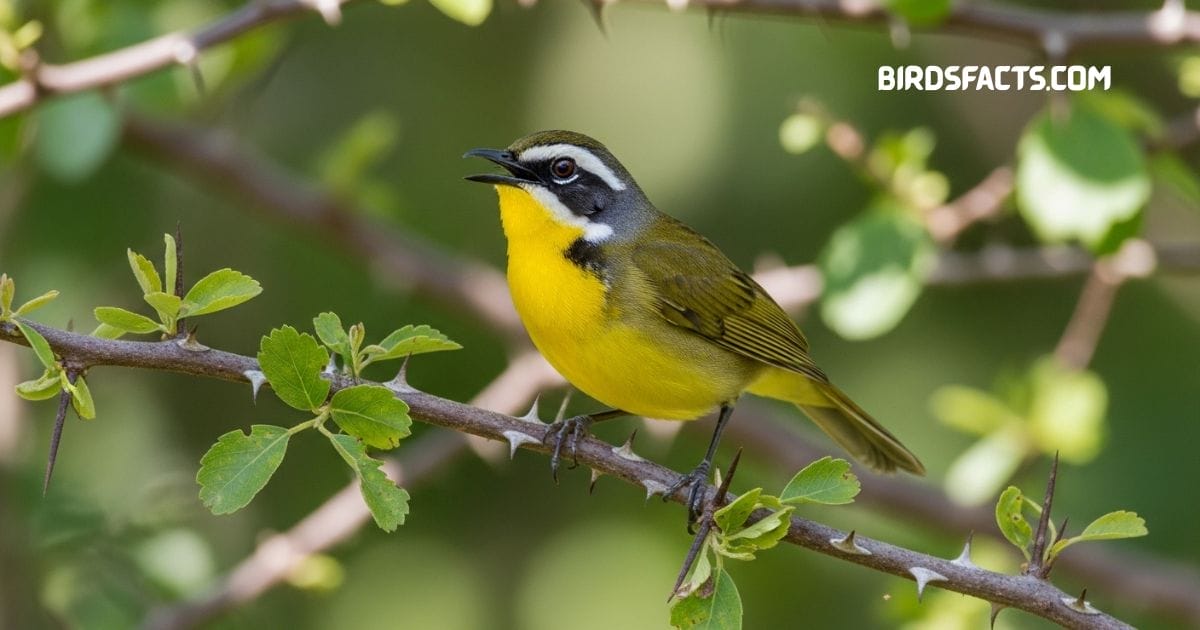
Yellow-breasted chat perched on shrub with bright yellow chest olive back and white spectacles
The Yellow Breasted Chat Is One Of The Most Unique Small Yellow Birds In North America Known For Its Bright Yellow Chest Olive Green Back And Distinct White Spectacles Around The Eyes. Though It Is The Largest Of Its Kind Its Classification Long Confused Ornithologists Because It Behaves Differently From Typical Warblers. These Birds Prefer Dense Thickets And Brushy Areas Where They Stay Hidden Yet Fill The Air With Their Whistles And Chattering Calls.
During Spring Males Of These Small Yellow Birds Perform Impressive Flight Displays Singing Loudly As They Rise And Glide Through The Air. Their Secretive Nature Makes Them More Often Heard Than Seen But Their Voices Are Unmistakable. They Migrate From The United States To Central America Each Year Showing Incredible Endurance. For Bird Lovers Spotting One Of These Small Yellow Birds Is A Rewarding Challenge That Combines Mystery Color And Melody All In One.
| Facts | Detail |
|---|---|
| Range | Found In North America Preferring Dense Thickets And Shrubby Areas |
| Key Fact | Largest Warbler In North America |
| Plumage | Bright Yellow Chest With White Spectacles And Olive Green Back |
| Behavior | Loud Varied Sometimes Mimicking Calls |
| Habitat | Dense Thickets Brushy Fields And Forest Edges |
Yellow Canary

Yellow canary perched on branch with bright yellow plumage and small pointed bill
The Yellow Canary Is One Of The Most Beloved Small Yellow Birds Native To Southern Africa Closely Related To The Domestic Canary. Its Bright Yellow Plumage And Sweet Song Have Made It A Favorite Both In The Wild And In Aviaries Around The World. In Its Natural Habitat It Thrives In Grasslands Gardens And Farmland Edges Where Its Melodious Voice Is Often Compared To Sunshine In Bird Form.
These Cheerful Small Yellow Birds Feed Mostly On Seeds But Also Catch Tiny Insects During The Breeding Season. They Are Highly Adaptable Often Living Near Human Settlements And Taking Advantage Of Available Food Sources. Their Wild Populations Continue To Flourish In Africa While Their Domesticated Relatives Have Spread Globally. For Bird Watchers Hearing These Small Yellow Birds Singing Freely In Southern Africa Is A Bright And Joyful Moment Worth Remembering.
| Facts | Detail |
|---|---|
| Range | Native To Southern Africa |
| Key Fact | Bright Yellow Plumage With Sweet Melodious Song |
| Plumage | Golden Yellow Body With Slightly Darker Wings |
| Behavior | Adaptable To Gardens And Farmland |
| Diet | Primarily Eats Seeds With Some Insects In Diet |
Yellow-Fronted Canary
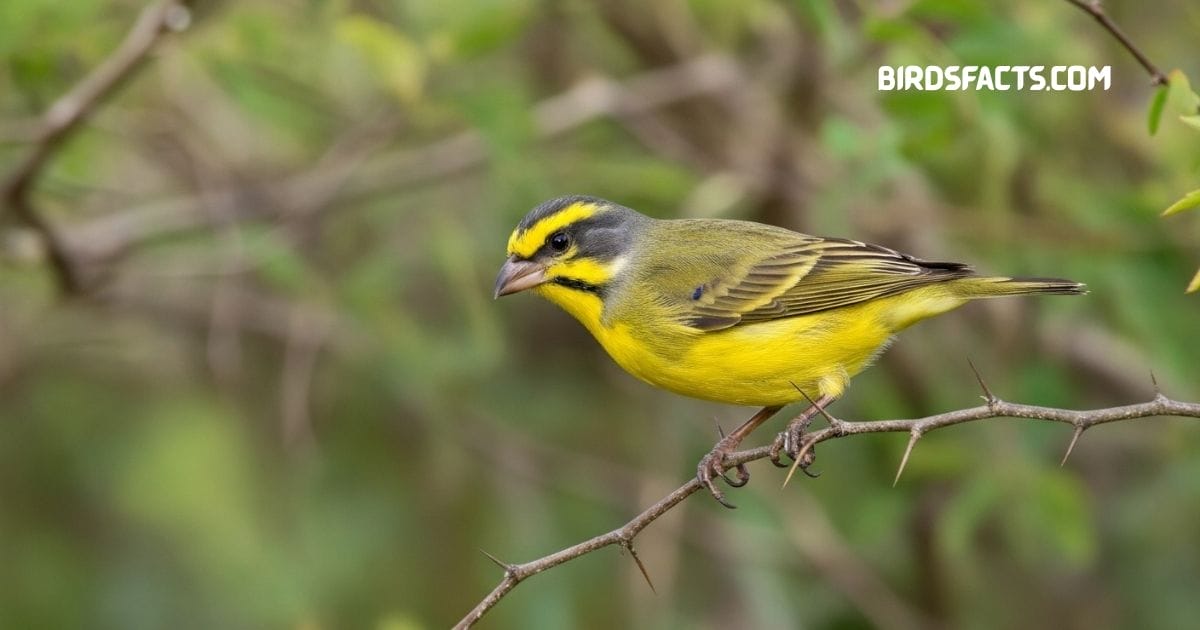
Yellow-fronted canary perched on branch with yellow body greenish back and distinct dark crown
The Yellow Fronted Canary Is One Of The Most Attractive Small Yellow Birds Found Across Africa Easily Recognized By Its Bright Yellow Face And Underparts With Olive Green Wings And Back. Unlike The Yellow Canary It Shows Fine Streaking On The Sides And A Sharply Defined Yellow Facial Patch. This Finch Like Species Thrives In Savannas Gardens And Open Woodlands Often Moving About In Small Flocks That Fill The Air With Sound And Color.
Its Song Is A Fast Light Series Of Notes That Ring Like Tiny Bells Making It A Joy To Hear Among Other Small Yellow Birds. Though Often Kept As A Cage Bird In Some Regions It Lives Most Vibrantly In The Wild Where It Forages For Seeds Grains And Occasional Insects. Their Adaptability Has Helped Them Spread Widely Across Africa. Watching These Small Yellow Birds Flutter And Feed Together Brings The Spirit Of The African Landscape To Life.
| Facts | Detail |
|---|---|
| Range | Native To African Savannas And Open Woodlands |
| Key Fact | Bright Yellow Face And Underparts With Streaked Sides |
| Plumage | Yellow Underparts With Olive Streaked Upperparts |
| Behavior | Cheerful Fast Tinkling Song |
| Diet | Eats Seeds Grains And Small Insects |
Yellow-Headed Wagtail
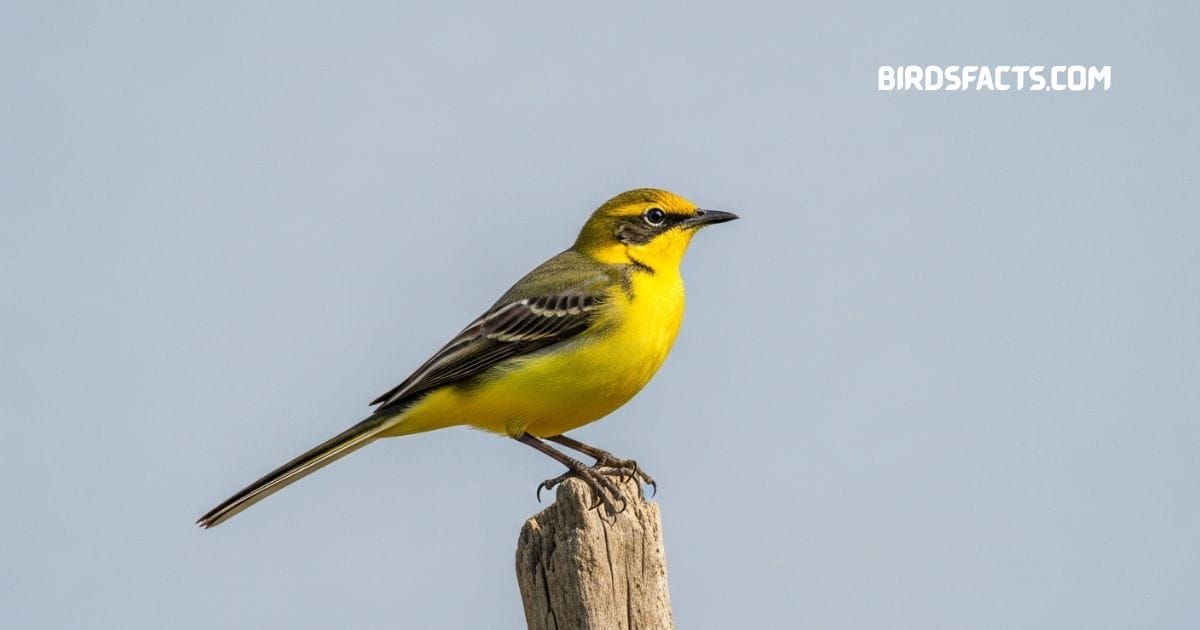
Yellow-headed wagtail standing near water with bright yellow head olive back and slender tail
The Yellow Headed Wagtail Is One Of The Most Eye Catching Small Yellow Birds Found Across Eurasia. During The Breeding Season Males Glow With Bright Yellow Heads And Underparts Contrasted By Olive Green Backs And Wings. They Prefer Wet Meadows Riverbanks And Marshy Fields Where They Gracefully Walk While Foraging For Insects. Their Constant Tail Wagging Is A Signature Trait That Makes These Birds Easy To Recognize Even From Afar.
Like Many Other Small Yellow Birds The Yellow Headed Wagtail Is A Long Distance Migrant Traveling From Northern Europe And Asia To Africa And South Asia For Winter. Their Adapt Ability Allows Them To Thrive In Farmlands Following Livestock To Catch Stirred Up Insects. Though Their Colors Are Brilliant They Often Blend Into Grassy Fields Making Them A Delightful Challenge To Spot. For Bird Lovers Watching These Small Yellow Birds Move Through Wetlands Is A Joyful Glimpse Into The Rhythm Of Nature.
| Facts | Detail |
|---|---|
| Range | Found In Eurasian Wetlands And Meadows |
| Key Fact | Bright Yellow Head Chest And Belly In Males During Breeding Plumage |
| Plumage | Yellow Underparts With Olive Green Back And Long Tail |
| Behavior | Constantly Wags Tail While Foraging |
| Migration | Long Distance Migrant To Africa And South Asia |
Yellow Oriole
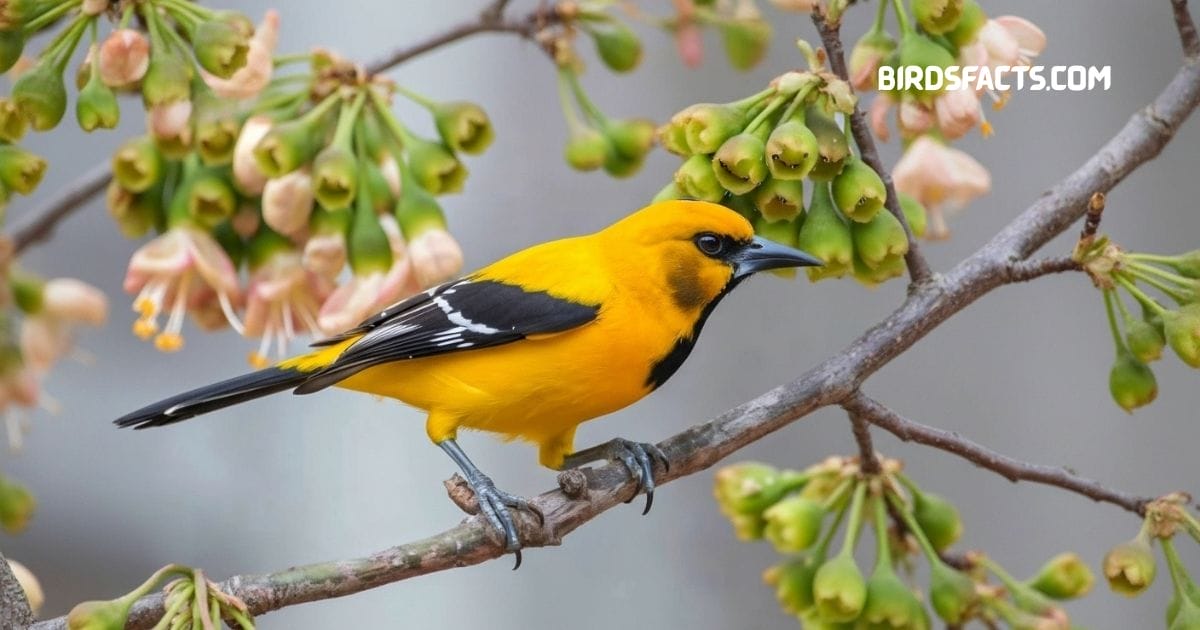
Yellow oriole perched on branch with bright yellow body black wings and black eye line
The Yellow Oriole Is One Of The Most Striking Small Yellow Birds Of Central And South America Its Lemon Yellow Plumage Contrasts Beautifully With Black Wings And A Dark Eye Line. It Thrives In Open Wood Lands Gardens And Forest Edges Where Its Flute Like Song Rings Out From The Treetops. Unlike Some Orioles That Weave Hanging Nests The Yellow Oriole Builds A Simple Cup Shaped Nest Among Branches And Its Bright Feathers Make It Easy To Spot Even From Afar.
Like Many Tropical Small Yellow Birds It Has A Varied Diet That Includes Fruits Nectar And Insects Allowing It To Adapt To Different Habitats. These Orioles Are Frequent Visitors To Flowering Gardens And Fruiting Trees Often Seen Perched Boldly While Singing. In Regions Such As Trinidad And Northern South America They Are Among The Most Common Orioles And Their Cheerful Voices Bring Warmth And Color To Every Landscape. Watching These Small Yellow Birds Feels Like Seeing The Tropics Come Alive In Motion.
| Facts | Detail |
|---|---|
| Range | Found In Central America And South America Forests And Gardens |
| Key Fact | Bright Yellow Body With Black Wings And Eye Line |
| Plumage | Yellow Plumage With Black Wing Feathers And Eye Line |
| Behavior | Known For Melodious Flute Like Song |
| Diet | Eats Fruits Nectar And Insects |
Yellow-Throated Vireo

Yellow-throated vireo perched on branch with yellow throat olive back and white wing bars
The Yellow Throated Vireo Is One Of The Most Distinctive Small Yellow Birds In Eastern North America Recognized By Its Bright Yellow Throat And Chest Olive Green Back And Crisp White Wing Bars. Its Burry Song Sounds Like “three Eight Three Eight” Making It Easy To Identify Even When Hidden Among Leaves. These Birds Prefer Deciduous Forests During Breeding Season Before Migrating South To Central America And The Caribbean For Winter.
Unlike Many Small Yellow Birds The Yellow Throated Vireo Often Perches Openly Singing With Determination. It Hunts For Insects Among Branches But Also Feeds On Berries During Migration Giving It A Balanced Diet. Birdwatchers Admire This Species For Its Vivid Colors And Steady Clear Voice Which Carries Through The Trees. Spotting One Of These Small Yellow Birds On A Spring Morning Is A Rewarding Sight That Marks The Changing Of The Seasons.
| Facts | Detail |
|---|---|
| Range | Breeds In Eastern North America / Winters In Central America And The Caribbean |
| Key Fact | Bright Yellow Throat And Chest With Olive Green Back |
| Plumage | Yellow Underparts With Olive Green Back And White Wing Bars |
| Behavior | Loud Burry Three Eight Song |
| Migration | Migrates To Central America And The Caribbean |
Yellow Warbler
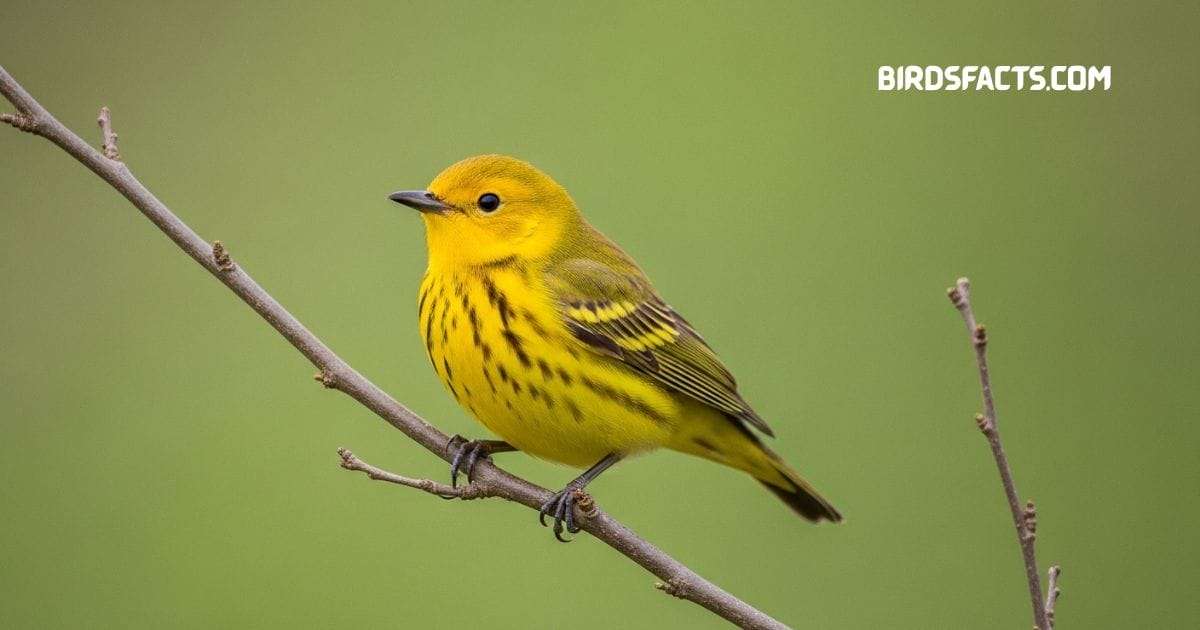
Yellow warbler perched on branch with bright yellow plumage reddish streaks and slender bill
The Yellow Warbler Is One Of The Most Recognizable Small Yellow Birds Across North America Shining Like A Ray Of Sunshine In Every Landscape. Males Display Soft Reddish Streaks On Their Chests While Females Glow In Pure Yellow. These Birds Thrive In Wetlands Woodlands And Shrubby Habitats Breeding Across The Continent Before Migrating To Central And South America For Winter. Their Gentle Whistling Song “sweet Sweet Sweet I’m So Sweet” Brings The Spirit Of Spring Wherever It’s Heard.
Among All Small Yellow Birds The Yellow Warbler Stands Out For Its Adapt Ability And Widespread Presence. It Feeds Mostly On Insects But Will Also Enjoy Small Berries During Migration. For Bird Lovers Its Friendly Nature And Vibrant Plumage Make It The Perfect Introduction To Birdwatching. Watching One Sing From A Branch Or Flit Through Green Leaves Is A Reminder Of How Small Yellow Birds Can Brighten Even The Quietest Corners Of Nature.
| Facts | Detail |
|---|---|
| Range | Breeds Across North America In Wetlands And Woodlands / Winters In Central America And South America |
| Key Fact | Entirely Yellow Plumage With Reddish Streaks In Males |
| Plumage | Bright Yellow Body With Reddish Chest Streaks In Males |
| Behavior | Song Sweet Sweet Sweet Im So Sweet |
| Migration | Long Distance Migrant To Central America And South America |
Yellow Cardinal
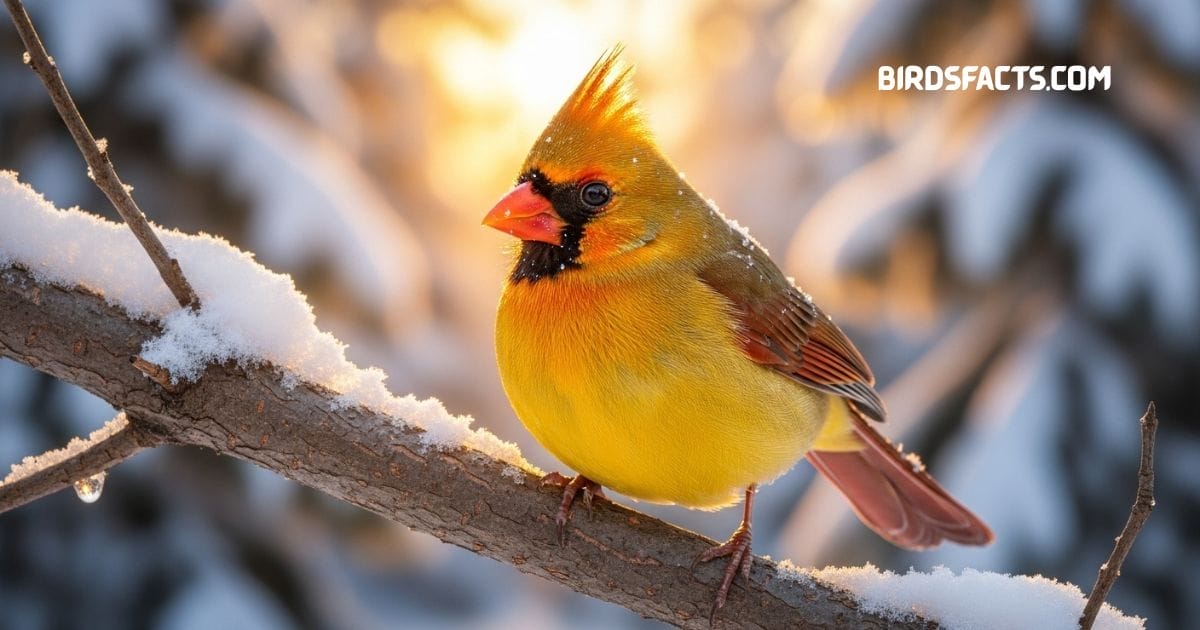
VYellow cardinal perched on branch with golden yellow plumage black mask and pointed crest
The Yellow Cardinal Is One Of The Rarest And Most Stunning Small Yellow Birds In South America. Found Mainly In Argentina Paraguay And Uruguay It Resembles The Familiar Northern Cardinal But Glows With A Golden Yellow Body Instead Of Red. Males Display A Striking Crest And Black Mask While Females Show Softer Yellow Tones. Sadly This Species Faces Decline Due To Habitat Loss And Capture For The Pet Trade.
These Small Yellow Birds Live In Dry Woodlands And Scrubby Grasslands Where They Feed On Seeds Fruits And Insects. Their Sweet Whistled Song Resembles That Of The Northern Cardinal Filling The Landscape With A Cheerful Tune. Conservation Efforts Are Working To Protect Their Fragile Populations But Sightings Remain Rare. For Bird Lovers Seeing One Of These Small Yellow Birds In The Wild Is A Moment Of Pure Wonder And A Reminder Of How Precious Nature’s Beauty Can Be.
| Facts | Detail |
|---|---|
| Range | Found In South America Scrubby Grasslands And Woodlands |
| Key Fact | Males Have Golden Yellow Plumage With Black Masks And Crests |
| Plumage | Bright Golden Yellow In Males Females Duller With Brownish Tones |
| Behavior | Perches Prominently And Sings Musical Whistles |
| Status | Rare Endangered Species Threatened By Habitat Loss And Pet Trade |
Frequently Asked Questions (FAQs)
What Is The Most Common Small Yellow Bird In Backyards?
The American Goldfinch Is One Of The Most Common And Easily Recognized Backyard Yellow Birds.
Do All Small-yellow-birds Migrate?
No Some Species Like The Pine Warbler May Stay Year-round While Others Migrate Long Distances.
How Can I Tell Male And Female Yellow Birds Apart?
Males Are Usually Brighter While Females Have Duller Yellow Or Olive Tones For Camouflage.
What Food Attracts Yellow Songbirds?
Sunflower Seeds Thistle And Suet Are Favorites For Finches Warblers And Other Yellow Birds.
Where Is The Best Place To See Small Yellow Birds?
They Can Be Seen In Gardens Wetlands Forests And During Spring Or Fall Migration
Conclusion
Small Yellow Birds Bring Joy Color And Energy To Every Landscape Whether It’s A Garden Feeder A Quiet Marsh Or A Forest Canopy. From The Cheerful American Goldfinch To The Bright Yellow Warbler These Tiny Treasures Represent Some Of The Most Beloved Songbirds Across North America Each With Its Own Story Song And Personality That Inspire Bird Watchers Everywhere.
If You’ve Ever Stopped To Watch Small Yellow Birds Fluttering Among Leaves You Know How Much Happiness They Bring. Learning About Their Habits Migration And Diet Helps You Appreciate Their Role In Nature And Attract Them To Your Backyard With The Right Plants Or Feeders. For Both Beginners And Experienced Birders Spotting These Small Yellow Birds Always Feels Like Finding A Piece Of Sunshine Alive And Singing Just For You.
Further Reading
You May Also Check Out:
- Small Black Bird with White Belly
- Birds With Orange Beaks
- Big Birds in Ohio
- Florida Birds with Long Beaks
- Skynettool Fire Tool
Thank You For Reading!

